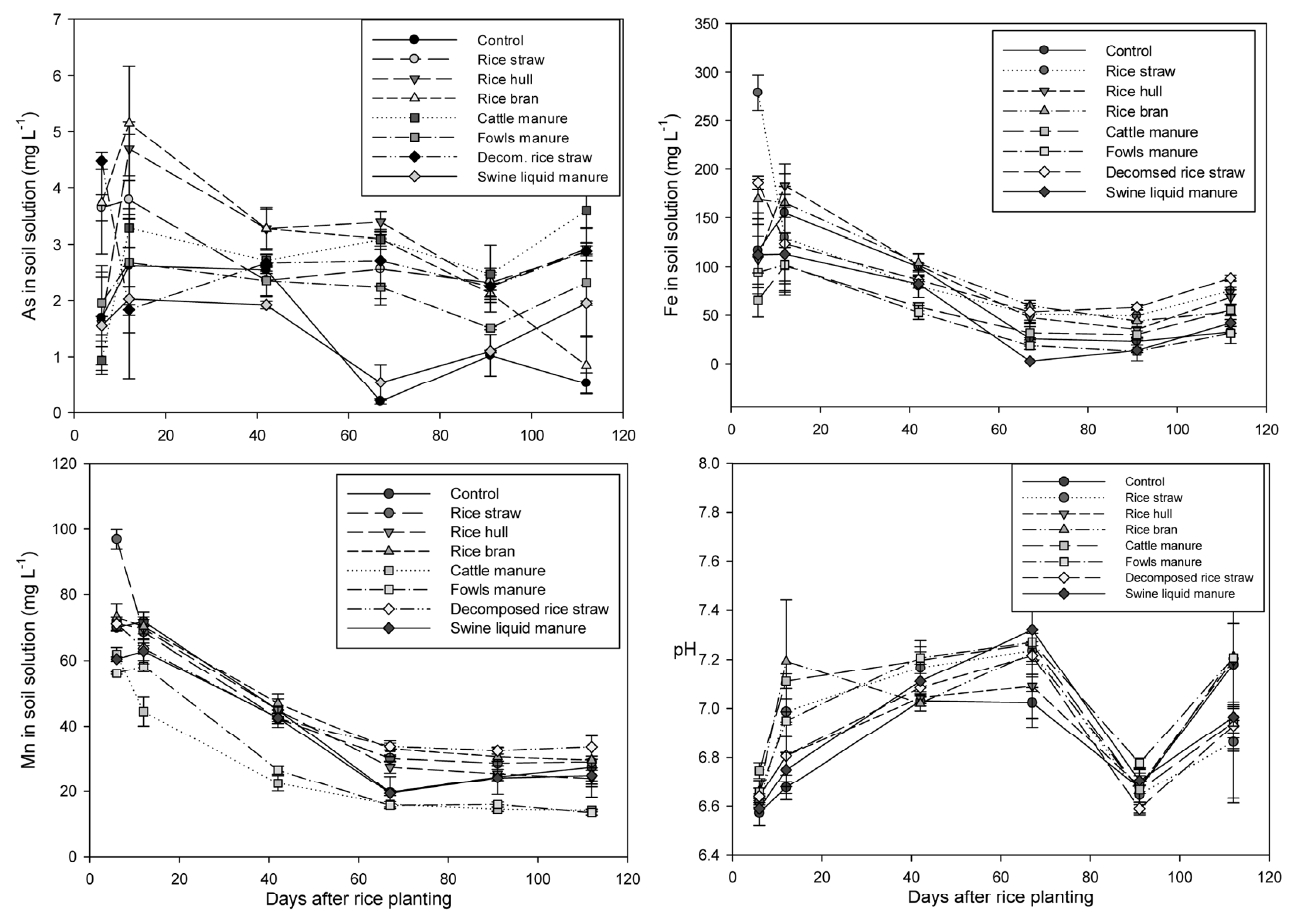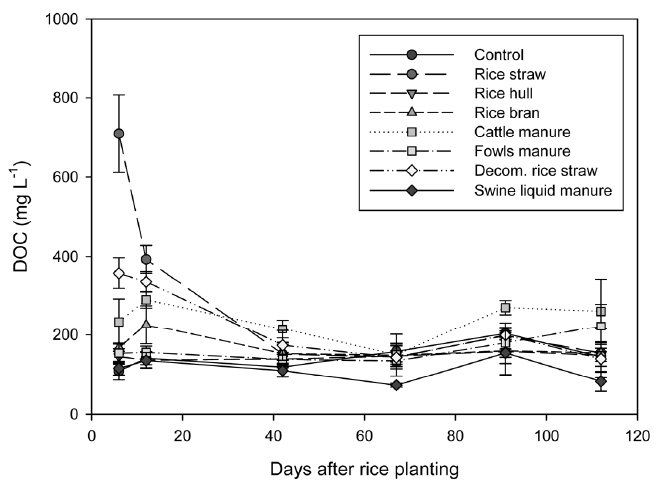 |
 |
- Search
| J Environ Anal Health Toxicol > Volume 23(4); 2020 > Article |
|
ABSTRACT
A pot experiment was conducted to evaluate the effect of organic matter addition to paddy soil on the solubility of arsenic (As), iron (Fe), and manganese (Mn) in soil and on As uptake by rice. Organic matter (rice straw, cattle manure, fowls manure, and swine liquid manure), except for rice hull and rice bran (the highest C:N ratio) had no effect on As release from the soil until the middle of the growth period of rice. However, As concentration in soil solution after that time was relatively high for all treatments. This result was probably attributable to the organic matter induced reductive dissolution of Fe (hydr)oxides combined with As in soil. As concentration in soil solutions from rice hull, rice bran, and cattle manure treatments was about four times higher than that of the control, since the panicle formation stage and the As concentration in brown rice from the treatments was 0.68-0.82 mg kg-1, which was about two times higher than that of the control. The As content in brown rice from swine liquid manure (the lowest C:N ratio) treatment was 0.33-0.36 mg kg-1, similar to the control. Our study indicates that some organic matter addition to paddy soil with high As concentration could cause As release from the soil and consequently elevate its concentrations in rice grain. We recommend swine liquid manure among the studied organic matter to be added to paddy soil, where As concentration is high.
ĒÖśĻ▓ĮņŚÉ ņĪ┤ņ×¼ĒĢśļŖö ļ╣äņåīļź╝ ĻĄ¼ņä▒ĒĢśļŖö ļ╣äņåī ņóģ Ļ░ĆņÜ┤ļŹ░ ļ¼┤ĻĖ░ļ╣äņåīļŖö 1ĻĄ░ ļ░£ņĢöļ¼╝ņ¦ł[1]ļĪ£ ļ╣äņåīņØś ņ£ĀĒÜ©ļÅäĻ░Ć ņāüļīĆņĀüņ£╝ļĪ£ ļåÆņØĆ ļŗ┤ņłś ĒÖśņøÉņĪ░Ļ▒┤ņØś ļ▓╝ņŚÉņä£ Ļ│ĀļåŹļÅäļĪ£ ņČĢņĀüļÉśļŖö Ļ▓āņ£╝ļĪ£ ņĢīļĀżņĀĖ ņ׳ņ£╝ļ®░[2], ņåīļ╣äņ×ÉņØś Ļ▒┤Ļ░Ģļ│┤ĒśĖņÖĆ ņŗØĒÆłĻĄÉņŚŁ ņŗ£ Ļ│ĄņĀĢĒĢ£ ļ¼┤ņŚŁņØä ļ│┤ņןĒĢśĻĖ░ ņ£äĒĢ┤ ņŗØĒÆłĻĘ£Ļ▓®ņØä ņĀ£ņĀĢĒĢśļŖö ĻĄŁņĀ£ĻĖ░ĻĄ¼ņØĖ ņĮöļŹ▒ņŖż (CODEX, ĻĄŁņĀ£ņŗØĒÆłĻĘ£Ļ▓®ņ£äņøÉĒÜī)ņŚÉņä£ ĻĄŁņĀ£ļ¼┤ņŚŁņŚÉņä£ ņīĆņØś ļ¼┤ĻĖ░ļ╣äņåī ņĢłņĀäĻ┤Ćļ”¼ļź╝ ņ£äĒĢ┤ ļ░▒ļ»ĖņÖĆ Ēśäļ»ĖņØś ļ¼┤ĻĖ░ļ╣äņåī ņĄ£ļīĆ ĒŚłņÜ®ĻĖ░ņżĆņØä Ļ░üĻ░ü 2014ļģäĻ│╝ 2016ļģäņŚÉ ņäżņĀĢĒĢśņśĆĻ│Ā[3,4] ņÜ░ļ”¼ļéśļØ╝ļŖö 2016ļģäņŚÉ ļ░▒ļ»ĖņØś ļ¼┤ĻĖ░ļ╣äņåī ĻĖ░ņżĆņØä ņäżņĀĢĒĢśņśĆļŗż[5]. ļśÉĒĢ£, ņĮöļŹ▒ņŖżļŖö ņāØņé░ļŗ©Ļ│äņŚÉņä£ņØś ņĢłņĀäņä▒ ĒÖĢļ│┤ļź╝ ņ£äĒĢ┤ ŌĆ£ņīĆņØś ļ╣äņåī ņśżņŚ╝ ļ░®ņ¦Ć ļ░Å ņĀĆĻ░ÉĒÖö ņŗżĒ¢ēĻĘ£ļ▓öŌĆØņØä ņäżņĀĢĒĢśņśĆļŗż[6]. ņØ┤ ĻĘ£ļ▓öņØĆ ļ▓╝ņØś ļ╣äņåī ĒØĪņłś ņĀĆĻ░ÉņØä ņ£äĒĢ£ ļ¼╝ Ļ┤Ćļ”¼, ļ╣äņåī ņĀĆĒØĪņłś ĒÆłņóģ ņ×¼ļ░░ ļō▒ ņśüļåŹņĀü ļ░®ļ▓ĢņØä ĒżĒĢ©ĒĢśļ®░, ņ£ĀĻĖ░ļ¼╝ ļō▒ ĒåĀņ¢æĻ░£ļ¤ēņĀ£ ņŗ£ņÜ®ņØä ĒåĄĒĢ£ ļ╣äņåī ņĀĆĻ░ÉņŚÉ Ļ┤ĆĒĢ£ ņČöĻ░Ć ņŚ░ĻĄ¼ņØś ĒĢäņÜöņä▒ņØä ņ¢ĖĻĖēĒĢśĻ│Ā ņ׳ļŗż. ļåŹņ┤īņ¦äĒØźņ▓ŁņŚÉņä£ļŖö ņīĆņØś ļ¼┤ĻĖ░ļ╣äņåī ņĢłņĀäņä▒ ļ¼ĖņĀ£Ļ░Ć ĻĄŁņĀ£ņĀüņ£╝ļĪ£ ļīĆļæÉ[7]ļÉśĻĖ░ ņĀäņØĖ 2004ļģä, ļ╣äņåī ņśżņŚ╝ ļåŹĻ▓Įņ¦ĆņŚÉ ļīĆĒĢ£ ĒåĀņ¢æ Ļ░£ļ¤ē ļīĆņ▒ģņ£╝ļĪ£ ņ£ĀĻĖ░ļ¼╝ ņŗ£ņÜ®ņØä ņČöņ▓£ĒĢśņśĆļŖöļŹ░ ņØ┤ļŖö, ĒåĀņ¢æ ņżæ ņ£ĀĻĖ░ļ¼╝ņØĆ ļ╣äņåīņÖĆ Ļ░ĆņÜ®ņä▒, ļśÉļŖö ļČłņÜ®ņä▒ ļ│ĄĒĢ®ņ▓┤ļź╝ ĒśĢņä▒ĒĢśļ»ĆļĪ£ ļ╣äņåīņØś ņØ┤ļÅÖĻ│╝ņĀĢņŚÉ ņżæņÜöĒĢ£ ņŚŁĒĢĀņØä ĒĢśļ®░[8,9], ļ╣äņåīņÖĆ ņ£ĀĻĖ░ ļ│ĄĒĢ®ņ▓┤ļź╝ ĒśĢņä▒ĒĢśļŖö Ļ│╝ņĀĢņŚÉņä£ ļ╣äņåīļź╝ ņłśņ░®(sorption, ĒØĪņłśņÖĆ ĒØĪņ░®ņØ┤ ļÅÖņŗ£ņŚÉ ņ¦äĒ¢ē) ĒĢśļ»ĆļĪ£[10] ņ£ĀĻĖ░ļ¼╝ ĒĢ©ļ¤ēņØ┤ ļåÆņØĆ ĒåĀņ¢æņŚÉņä£ļŖö ļ╣äņåīņØś ņŗØļ¼╝ ņ£ĀĒÜ©ļÅäĻ░Ć Ļ░ÉņåīĒĢśļŖö ĻĖ░ņ×æņŚÉ ļö░ļźĖ Ļ▓āņØ┤ļŗż[11]. ļśÉĒĢ£, ņ£ĀĻĖ░ļ¼╝ņØś ņ”ØĻ░ĆļŖö ļ»ĖņāØļ¼╝ ĒÖ£ļÅÖņØä ņ┤ēņ¦äĒĢśņŚ¼ ļÅģņä▒ņØ┤ ļåÆņØĆ ļ¼┤ĻĖ░ļ╣äņåī ņóģņØś ļÅģņä▒ņØ┤ ļé«ņØĆ ņ£ĀĻĖ░ļ╣äņåī ņóģņ£╝ļĪ£ņØś ļīĆņé¼Ļ░Ć ņ”ØĻ░ĆĒĢĀ ņłś ņ׳ļŗż[12].
ĒĢ£ĒÄĖ, ņ£ĀĻĖ░ļ¼╝ ņŗ£ņÜ®ņØĆ ĒÖśĻ▓ĮņĪ░Ļ▒┤ņŚÉ ļö░ļØ╝ ņāüļ░śļÉśļŖö ņśüĒ¢źņØä ļ»Ėņ╣Ā ņłś ņ׳ļŖöļŹ░ ļģ╝Ļ│╝ Ļ░ÖņØĆ ļŗ┤ņłś ņĪ░Ļ▒┤ņŚÉņä£ ļ╣äņåīņØś ņÜ®ĒĢ┤ļÅäļŖö pH, ņ▓Ā┬Ęļ¦ØĻ░ä (ņłś)ņé░ĒÖöļ¼╝ ļ░Å ņÜ®ņĪ┤ņ£ĀĻĖ░Ēāäņåī(Dissolved Organic Carbon, DOC) ļō▒ņØś ņśüĒ¢źņØä ļ░øņ£╝ļ®░[13,14], ņ▓Ā (ņłś)ņé░ĒÖöļ¼╝ņØś Ļ▓ĮņÜ░ ņ£ĀĻĖ░ļ¼╝ ļČäĒĢ┤ ļ»ĖņāØļ¼╝ņØ┤ ņé░ņåīļź╝ ņåīļ╣äĒĢśņŚ¼ ĒåĀņ¢æ ņé░ĒÖöĒÖśņøÉņĀäņ£äĻ░Ć Ļ░ÉņåīĒĢśļ®┤ņä£ ļ╣äņåīņÖĆ Ļ▓░ĒĢ®ĒĢ£ ņ▓Ā (ņłś)ņé░ĒÖöļ¼╝ņØś ĒÖśņøÉņĀü ņÜ®ĒĢ┤[15,16]ļĪ£ ņØĖĒĢ┤ ļ╣äņåīņØś ņÜ®ĒĢ┤ļÅäĻ░Ć ņ”ØĻ░ĆĒĢśĻ▓ī ļÉ£ļŗż. ļ¦ØĻ░ä (ņłś)ņé░ĒÖöļ¼╝ļÅä ļŗ┤ņłś ņĪ░Ļ▒┤ņŚÉņä£ ņ▓Ā (ņłś)ņé░ĒÖöļ¼╝Ļ│╝ Ļ░ÖņØĆ Ļ│╝ņĀĢņØä Ļ▒░ņ│É ņłśņ░®ļÉśņ¢┤ ņ׳ļŹś ļ╣äņåīĻ░Ć ĒåĀņ¢æ Ļ│ĄĻĘ╣ņłśļĪ£ ņÜ®ņČ£ļÉśņ¢┤ ļ╣äņåīņØś ņŗØļ¼╝ ņ£ĀĒÜ©ļÅä ņ”ØĻ░Ćļź╝ ņ£Āļ░£ĒĢ£ļŗż[17,18].
ņØ┤ņÖĆ Ļ░ÖņØ┤ ļ╣äņåīļź╝ ņłśņ░®ĒĢśĻ│Ā ņ׳ļŖö ĒåĀņ¢æņŚÉ ĒĢ©ņ£ĀļÉ£ ņ▓Ā┬Ęļ¦ØĻ░ä (ņłś)ņé░ĒÖöļ¼╝ņØĆ ļŗ┤ņłś ņĪ░Ļ▒┤ņŚÉņä£ ļ╣äņåī, ņ▓Ā ļ░Å ļ¦ØĻ░äņØä ĒĢ©Ļ╗ś ņÜ®ņČ£ĒĢśļ»ĆļĪ£ ņ£ĀĻĖ░ļ¼╝ ņŗ£ņÜ®ņŚÉ ļö░ļźĖ Ļ│ĄĻĘ╣ņłś ņżæņØś ņ▓ĀĻ│╝ ļ¦ØĻ░äņØś ļåŹļÅä ļ│ĆĒÖöļŖö ļ╣äņåīņØś ņÜ®ĒĢ┤ļÅäņŚÉ ļīĆĒĢ£ Ļ░äņĀæņĀüņØĖ ņĀĢļ│┤ļź╝ ņĀ£Ļ│ĄĒĢśļ®░, ņØ┤ļŖö ĒĢ┤ļŗ╣ ĒåĀņ¢æņØś ņ▓Ā┬Ęļ¦ØĻ░ä (ņłś)ņé░ĒÖöļ¼╝ ĒĢ©ļ¤ē ļō▒ ĒåĀņ¢æĒÖöĒĢÖņä▒ņØś ņśüĒ¢źļÅä ļ░øņ£╝ļ»ĆļĪ£ ĒåĀņ¢æ ņżæ ļ╣äņåī ņÜ®ĒĢ┤ļÅä ļ│ĆĒÖö ņŚ░ĻĄ¼ņŚÉ ĒĢäņłśņĀüņØĖ ņÜöņåīļØ╝Ļ│Ā ĒĢĀ ņłś ņ׳ļŗż.
ļ╣äņåīņØś ņÜ®ĒĢ┤ļÅäņŚÉ ļ»Ėņ╣śļŖö DOCņÖĆ Ļ┤ĆļĀ©ļÉ£ ĻĖ░ņ×æņ£╝ļĪ£ļŖö ĒÖśņøÉņāüĒā£ņØś ņé░ņä▒ĒåĀņ¢æņŚÉņä£ ņ£ĀĻĖ░ļ¼╝ņØ┤ ļČäĒĢ┤ļÉśļ®┤ņä£ DOCĻ░Ć Ļ▓░ĒĢ®ĒĢśĻ│Ā ņ׳ļŹś ļ╣äņåīņÖĆ ĒĢ©Ļ╗ś Ļ│ĄĻĘ╣ņłśļĪ£ ņÜ®ņČ£ļÉśļ®░[14,19], ņÜ®ņĪ┤ņ£ĀĻĖ░ļ¼╝ņØĆ ļ╣äņåīņÖĆ Ļ▓Įņ¤üĒĢśļŖö ĒåĀņ¢æ ļé┤ ņłśņ░® ļ░śņØæ Ļ│╝ņĀĢņŚÉņä£ ļ╣äņåīņØś ņØ┤ļÅÖņä▒ ņ”ØĻ░Ćļź╝ ņ£Āļ░£ĒĢśļ»ĆļĪ£[20] DOCļŖö Ļ░ĆņÜ®ņä▒ ļ╣äņåīņØś Ļ▒░ļÅÖņØä Ļ▓░ņĀĢĒĢśļŖö ņżæņÜö ņØĖņ×ÉĻ░Ć ļÉĀ ņłś ņ׳ļŗż[21]. ļö░ļØ╝ņä£, ņ£ĀĻĖ░ļ¼╝ ņŗ£ņÜ®ņØĆ ĒåĀņ¢æ ņżæ ļ╣äņåīņØś ņÜ®ņČ£ņØä ņ”ØĻ░Ćņŗ£ņ╝£ ļ▓╝ņØś ļ╣äņåī ņČĢņĀüņØä ņ£Āļ░£ĒĢĀ ņłś ņ׳ņ£╝ļ®░[22] ļ╣äņåī ļåŹļÅäĻ░Ć ļåÆņØĆ ļģ╝ņŚÉ ņ£ĀĻĖ░ļ¼╝ņØä ņŗ£ņÜ®ĒĢĀ Ļ▓ĮņÜ░ ņīĆņØś ļ╣äņåī ļåŹļÅäĻ░Ć ņ”ØĻ░ĆĒĢśĻ│Ā ļ▓╝ ņāØņ£ĪņØä ņĀĆĒĢ┤ĒĢĀ ņłś ņ׳ņ£╝ļ»ĆļĪ£ ņŻ╝ņØśĻ░Ć ĒĢäņÜöĒĢśļŗż[12].
ĻĄŁļé┤ ĒÅÉĻĖłņåŹ Ļ┤æņé░ ņ¦ĆņŚŁņØś ņżæĻĖłņåŹ ņśżņŚ╝ ļåŹĻ▓Įņ¦ĆļŖö ļģ╝ņØś Ļ▓ĮņÜ░ ņŻ╝ļĪ£ ļ╣äņåīļĪ£ ņśżņŚ╝ļÉśņ¢┤ ņ׳ņ¢┤ ņ£ĀĻĖ░ļ¼╝ ņŗ£ņÜ®ņØ┤ ļ▓╝ņØś ļ╣äņåī ĒØĪņłśņŚÉ ļ»Ėņ╣śļŖö ņśüĒ¢źņŚÉ ļīĆĒĢ£ ĻĄ¼ļ¬ģņØ┤ ĒĢäņÜöĒĢśļéś, ņ£ĀĻĖ░ļ¼╝ ņŗ£ņÜ®ņØ┤ ĒåĀņ¢æ ņżæ ļ╣äņåī ņÜ®ĒĢ┤ļÅä ļ░Å ņ×æļ¼╝ ĒØĪņłśņŚÉ ļ»Ėņ╣śļŖö ņśüĒ¢źņŚÉ Ļ┤ĆĒĢ£ ĻĄŁļé┤ ņŚ░ĻĄ¼ļŖö ļ»Ėļ»ĖĒĢ£ ņŗżņĀĢņØ┤ļŗż. ļśÉĒĢ£, ĻĄŁņÖĖņŚÉņä£ ņłśĒ¢ēļÉ£ ĻĖ░ņĪ┤ņØś ņŚ░ĻĄ¼ļōżņØĆ ņŗżĒŚśņŗż ļé┤ ļ░░ņ╣ś ņŗżĒŚś (batch study)ņØ┤ ļŗżņłśņØ┤ļ®░, ļ▓╝ ņ×¼ļ░░ ņŗżĒŚśņØś Ļ▓ĮņÜ░ņŚÉļÅä ņ£ĀĻĖ░ļ¼╝ņØś ņóģļźśĻ░Ć ļŗżņ¢æĒĢśņ¦Ć ņĢŖĻ│Ā ĻĄŁļé┤ņŚÉņä£ ņé¼ņÜ®ļÉśĻ│Ā ņ׳ļŖö ņ£ĀĻĖ░ļ¼╝Ļ│╝ļŖö ņ░©ņØ┤Ļ░Ć ņ׳ļŗżļŖö ĒĢ£Ļ│äĻ░Ć ņ׳ļŗż. ļö░ļØ╝ņä£ ļŗżņ¢æĒĢ£ ņ£ĀĻĖ░ļ¼╝ņØä ļīĆņāüņ£╝ļĪ£ ĒĢśļŖö ņŗżĒŚśņØä ĒåĄĒĢ┤ ĻĖ░ņĪ┤ņØś ņŚ░ĻĄ¼ļź╝ ļ│┤ņÖäĒĢśĻ│Ā ļ╣äņåī ņśżņŚ╝ņ¦ĆņŚÉņä£ ņ£ĀĻĖ░ļ¼╝ ņŗ£ņÜ®ņØś ļ¼ĖņĀ£ņĀÉņØä Ļ▓ĆĒåĀĒĢśņŚ¼ ņśüļåŹ ĒśäņןņŚÉņä£ ĒÖ£ņÜ®ĒĢĀ ņłś ņ׳ļŖö ļīĆņĢł ļ¦łļĀ©ņØ┤ ņÜöĻĄ¼ļÉ£ļŗż. ļ│Ė ņŚ░ĻĄ¼ņŚÉņä£ļŖö ĒåĀņ¢æĻ░£ļ¤ēĻ│╝ ņ¢æļČä Ļ│ĄĻĖē ļ░Å ņ£ĀĻĖ░ļ¼╝ ĒĢ©ļ¤ē ņ”Øņ¦äņØä ļ¬®ņĀüņ£╝ļĪ£ ĻĄŁļé┤ ļåŹĻ▓Įņ¦ĆņŚÉ ņŻ╝ļĪ£ ņé¼ņÜ®ļÉśļŖö Ēāäņ¦łļ╣äĻ░Ć ņä£ļĪ£ ļŗżļźĖ 7ņóģņØś ņ£ĀĻĖ░ļ¼╝ņØä ļīĆņāüņ£╝ļĪ£ ļ╣äņåīļĪ£ ņśżņŚ╝ļÉ£ ļģ╝ĒåĀņ¢æņŚÉ ņ▓śļ”¼ĒĢĀ Ļ▓ĮņÜ░ ĒåĀņ¢æ ņżæ ļ╣äņåī, ļ¦ØĻ░ä ļ░Å ņ▓ĀņØś ņÜ®ĒĢ┤ļÅäņÖĆ ļ╣äņåīņØś ņ×æļ¼╝ ĒØĪņłśņŚÉ ļ»Ėņ╣śļŖö ņśüĒ¢ź ĻĄ¼ļ¬ģņØä ĒåĄĒĢ┤ ņīĆņØś ļ╣äņåī ņĢłņĀäņä▒ ĒÖĢļ│┤ļź╝ ņ£äĒĢ£ ņ£ĀĻĖ░ļ¼╝ ņŗ£ņÜ®ņØś ļ░®Ē¢źņØä ņĀ£ņŗ£ĒĢśĻĖ░ ņ£äĒĢ£ ņŗżĒŚśņØä ņłśĒ¢ēĒĢśņśĆļŗż.
ņŗżĒŚśņŚÉ ņé¼ņÜ®ĒĢ£ ĒåĀņ¢æņØĆ ņČ®ņ▓Łļé©ļÅä ņśłņé░ĻĄ░ņŚÉ ņ£äņ╣śĒĢ£ HY Ļ┤æņé░ ņØĖĻĘ╝ņØś ļ╣äņåī ņśżņŚ╝ļÅäĻ░Ć ļåÆņØĆ ļģ╝ņŚÉņä£ ņ▒äņĘ©ĒĢśņŚ¼ ĻĘĖļŖśņŚÉņä£ Ļ▒┤ņĪ░ĒĢśĻ│Ā 4 mm ņ▓┤ļĪ£ Ļ▒░ļźĖ Ēøä ņé¼ņÜ®ĒĢśņśĆĻ│Ā ĒåĀņ¢æĻ│╝ Ēś╝ĒĢ®ĒĢśĻĖ░ ņ£äĒĢ£ ņ£ĀĻĖ░ļ¼╝ņØĆ ļģ╝ĒåĀņ¢æņŚÉ ņŗ£ņÜ® Ļ░ĆļŖźĒĢ£ ņ£ĀĻĖ░ļ¼╝ ņżæņŚÉņä£ ņÖĢĻ▓©, ļ»ĖĻ░Ģ, ļ│Åņ¦Ü, ļ│Åņ¦ÜĒć┤ļ╣ä, ņÜ░ļČäĒć┤ļ╣ä, Ļ│äļČäĒć┤ļ╣ä ļ░Å Ļ░ĆņČĢļČäļć©ņĢĪļ╣äļź╝ ņäĀņĀĢĒĢśņśĆļŗż. ņ£ĀĻĖ░ļ¼╝ ņ▓śļ”¼ļ¤ēņØĆ ļ│Åņ¦Ü, ņÖĢĻ▓© ļ░Å ļČĆņłÖļ│Åņ¦ÜņØĆ ĒåĀņ¢æ Ļ▒┤ņĪ░ņżæļ¤ēņØś 1% ĒĢ┤ļŗ╣ļ¤ēņØä ņ▓śļ”¼ĒĢśņśĆĻ│Ā, ņ£ĀĻĖ░ļ¼╝ņØś ņ▓śļ”¼ļ¤ēņŚÉ ļö░ļźĖ ņ░©ņØ┤ļź╝ ļ│┤ĻĖ░ ņ£äĒĢśņŚ¼ ļ»ĖĻ░ĢĻ│╝ ņÜ░ļČäĒć┤ļ╣äļŖö ĒåĀņ¢æ Ļ▒┤ņĪ░ņżæļ¤ēņØś 1%ņÖĆ 3% ĒĢ┤ļŗ╣ļ¤ē, Ļ│äļČäĒć┤ļ╣äļŖö ĒåĀņ¢æ Ļ▒┤ņĪ░ņżæļ¤ēņØś 0.5%ņÖĆ 1.5%ņŚÉ ĒĢ┤ļŗ╣ĒĢśļŖö ņ¢æņØä ņ▓śļ”¼ĒĢśņśĆņ£╝ļ®░ Ļ░ĆņČĢļČäļć©ņĢĪļ╣äļŖö ĒåĀņ¢æ ņ£ĀĻĖ░ļ¼╝ ĒĢ©ļ¤ē ĻĖ░ņżĆņ£╝ļĪ£ ņČöņ▓£ņŗ£ņÜ®ļ¤ēĻ│╝ ņČöņ▓£ņŗ£ņÜ®ļ¤ēņØś 3ļ░░ļ¤ēņØä Ļ░üĻ░ü ņ▓śļ”¼ĒĢśņśĆļŗż (Table 1). Ļ░ü ņ£ĀĻĖ░ļ¼╝ņØä 3.2 kgņØś ĒåĀņ¢æĻ│╝ ņČ®ļČäĒ׳ Ēś╝ĒĢ® Ēøä 1/5,000 a ņÖĆĻĘĖļäłĒżĒŖĖņŚÉ 17 cm ļåÆņØ┤ļĪ£ ņČ®ņ¦äĒĢśņśĆņ£╝ļ®░ ļ▓╝ ņāØņ£ĪĻĖ░Ļ░ä ņżæ ĒåĀņ¢æņÜ®ņĢĪņØä ņ▒äņĘ©ĒĢśĻĖ░ ņ£äĒĢ┤ ĒåĀņ¢æņÜ®ņĢĪ ņ▒äņĘ©ĻĖ░ (Rhizon sampler, rhizosphere, the Netherlands)ļź╝ ĒżĒŖĖ ļŗ╣ 2Ļ░£ņö® ĒżĒŖĖ ļ░öļŗźņ£╝ļĪ£ļČĆĒä░ 9 cm ļåÆņØ┤ņŚÉ ņ£äņ╣śĒĢśļÅäļĪØ ņäżņ╣śĒĢśņśĆļŗż. ļ╣äļŻī ņŗ£ļ╣äļŖö ņ×æļ¼╝ļ│ä ņŗ£ļ╣äņ▓śļ░®ĻĖ░ņżĆ[23]ņŚÉ ļö░ļØ╝ ļ│┤ĒåĄļŗĄņØś ņīĆ ļ¬®Ēæ£ņłśļ¤ēņØĖ 4.8 Mg ha-1ņŚÉ ĒĢ┤ļŗ╣ĒĢśļŖö ņ¦łņåī, ņØĖņé░ ļ░Å ņ╣╝ļ”¼ņØś ņŗ£ļ╣äļ¤ēņØä Ļ░üĻ░ü ņÜöņåī, ņÜ®Ļ│╝ļ”░ ļ░Å ņŚ╝ĒÖöĻ░Ćļ”¼ļĪ£ ĒżĒŖĖ ņČ®ņ¦ä ņŗ£ņŚÉ ņŗ£ņÜ®ĒĢśĻ│Ā ĒåĀņ¢æĻ│╝ ņČ®ļČäĒ׳ Ēś╝ĒĢ®ĒĢśņśĆļŗż. ņČ®ņ¦äņØ┤ ņÖäļŻīļÉ£ ņÖĆĻĘĖļäłĒżĒŖĖņŚÉ ĒåĀņ¢æĒæ£ļ®┤ņ£╝ļĪ£ļČĆĒä░ 3 cm ļåÆņØ┤ļĪ£ ļ¼╝ņØä ņ▒äņÜ░Ļ│Ā ņĢłņĀĢĒÖö Ļ│╝ņĀĢņØä Ļ▒░ņ╣£ ļŗżņØī Ēīīņóģ Ēøä 3ņŻ╝ Ļ░ä ņ£Īļ¼śĒĢ£ ĒśĖļåŹļ▓╝ļź╝ 1ņŻ╝ 3ļ│Ėņ£╝ļĪ£ ĒżĒŖĖ ļŗ╣ 1ņŻ╝ļź╝ ņØ┤ņĢÖĒĢśņśĆļŗż.
ĒåĀņ¢æņŗ£ļŻīļŖö ĒåĀņ¢æĒÖöĒĢÖļČäņäØļ▓Ģ24)ņŚÉ ļö░ļØ╝ ņØīĻ▒┤ĒĢśņŚ¼ 2 mm ņ▓┤ņŚÉ Ļ▒░ļźĖ Ēøä pH (1:5), ņĀäĻĖ░ņĀäļÅäļÅä (EC, Electrical conductivity), ņ£ĀĻĖ░ļ¼╝ ĒĢ©ļ¤ē (ĒŖ£ļ”░ļ▓Ģ), ņ£ĀĒÜ©ņØĖņé░, ņ┤Ø ņ¦łņåī ĒĢ©ļ¤ē ļ░Å ĒåĀņä▒ (ļ╣äņżæĻ│äļ▓Ģ)ņØä ļČäņäØĒĢśņśĆļŗż. ĒåĀņ¢æ ņżæ ņżæĻĖłņåŹ ņ┤Ø ĒĢ©ļ¤ē ļČäņäØņØĆ ĒåĀņ¢æņśżņŚ╝Ļ│ĄņĀĢņŗ£ĒŚśĻĖ░ņżĆ[25]ņŚÉ ļö░ļØ╝ ĒÖśļźś ļāēĻ░üņןņ╣śļź╝ ņØ┤ņÜ®ĒĢśņŚ¼ ņĀäņ▓śļ”¼ Ēøä ņ┤łņł£ņłśļĪ£ ĒؼņäØĒĢśņŚ¼ ICP-MS (7700, Agilent, USA)ļĪ£ ņżæĻĖłņåŹ ļåŹļÅäļź╝ ļČäņäØĒĢśņśĆļŗż. ņżæĻĖłņåŹ ļČäņäØņØś ņŗĀļó░ļÅäļź╝ Ļ▓ĆņĀĢĒĢśĻĖ░ ņ£äĒĢ┤ ĒåĀņ¢æ ņØĖņ”Ø Ēæ£ņżĆļ¼╝ņ¦ł (BAM U112a, Germany)ņØä ņØ┤ņÜ®ĒĢśņŚ¼ ļČäņäØ ņĀĢĒÖĢļÅäļź╝ Ļ▓ĆņĀĢĒĢśņśĆņ£╝ļ®░, ĒåĀņ¢æņśżņŚ╝Ļ│ĄņĀĢņŗ£ĒŚśĻĖ░ņżĆņØä ļ¦īņĪ▒ĒĢśļŖö ļČäņäØ ņĀĢĒÖĢļÅä 85-110% ņĪ░Ļ▒┤ņŚÉņä£ ĒåĀņ¢æņŗ£ļŻīņżæņØś ņżæĻĖłņåŹ ļČäņäØņØä ņłśĒ¢ēĒĢśņśĆļŗż. ņŗ£ĒŚśĒåĀņ¢æņØś ļ¼╝ļ”¼ĒÖöĒĢÖņä▒ ļ░Å ņżæĻĖłņåŹ ĒĢ©ļ¤ēņØĆ Table 2 ļ░Å 3Ļ│╝ Ļ░Öļŗż.
ĒåĀņ¢æņÜ®ņĢĪņØĆ ņÖĆĻĘĖļäłĒżĒŖĖņŚÉ ĒåĀņ¢æ ņČ®ņ¦ä ņŗ£ ņäżņ╣śĒĢ£ rhizon samplerņÖĆ ņŻ╝ņé¼ĻĖ░ļź╝ ņØ┤ņÜ®ĒĢśņŚ¼ ņŻ╝ĻĖ░ņĀüņ£╝ļĪ£ ņ▒äņĘ© Ēøä ņ£ĀĻĖ░ļ¼╝ ņ▓śļ”¼ņŚÉ ļö░ļźĖ ĒåĀņ¢æņÜ®ņĢĪ ņżæ pH ļ│ĆĒÖöļź╝ ņĖĪņĀĢĒĢśĻ│Ā ļ╣äņåī, DOC, ņ▓Ā ļ░Å ļ¦ØĻ░äņØś ļåŹļÅäļź╝ ļČäņäØĒĢśņśĆņ£╝ļ®░, ĻĖ░ĻĖ░ļČäņäØņŚÉļŖö ICP-AES (Integra XL, GBC, Australia)ļź╝ ņØ┤ņÜ®ĒĢśņśĆļŗż. DOCļŖö TOC ļČäņäØĻĖ░ (LCPH, Shimadzu, Japan)ļź╝ ņØ┤ņÜ®ĒĢśņŚ¼ ļČäņäØĒĢśņśĆļŗż.
Ēśäļ»Ė ņżæ ļ╣äņåī ļ░Å ņ£ĀĻĖ░ļ¼╝ņØś ņżæĻĖłņåŹ ĒĢ©ļ¤ē ļČäņäØņØĆ ļåŹņ┤īņ¦äĒØźņ▓Ł ļåŹņŚģĻ│╝ĒĢÖĻĖ░ņłĀ ņŚ░ĻĄ¼ņĪ░ņé¼ļČäņäØĻĖ░ņżĆ[23]ņŚÉ ļö░ļØ╝ microwave digestion system (ETHOS 1, Milestone IT, Italy)ņØä ņØ┤ņÜ®ĒĢśņŚ¼ ņĀäņ▓śļ”¼ Ēøä ICP-MS (7700, Agilent, USA)ļĪ£ ļČäņäØĒĢśņśĆļŗż. ņŗØļ¼╝ņ▓┤ ņŗ£ļŻīņØś ņżæĻĖłņåŹ ļČäņäØ Ļ│╝ņĀĢņŚÉņä£ņØś ņŗĀļó░ļÅäļź╝ Ļ▓ĆņĀĢĒĢśĻĖ░ ņ£äĒĢśņŚ¼ ņØĖņ”ØĒæ£ņżĆļ¼╝ņ¦łņØĖ ņīĆ ļČäļ¦ÉņØä ņØ┤ņÜ®ĒĢśņŚ¼ ļ╣äņåī (ERM IRMM-804, Belgium) ļ░Å ļ¼┤ĻĖ░ļ╣äņåī (NIST 1568b, USA)ņØś ļČäņäØ ņĀĢĒÖĢļÅäļź╝ Ļ▓ĆņĀĢĒĢśņśĆņ£╝ļ®░ ņĀĢĒÖĢļÅä 85-115%ņØś ļČäņäØ ņĪ░Ļ▒┤ņŚÉņä£ ņŗ£ļŻīņżæņØś ņżæĻĖłņåŹ ļČäņäØņØä ņłśĒ¢ēĒĢśņśĆļŗż. ņŗżĒŚśņŚÉ ņé¼ņÜ®ĒĢ£ ņ£ĀĻĖ░ļ¼╝ņØś Ēāäņ¦łļ╣ä (C:N ratio) ņé░ņČ£ņØä ņ£äĒĢ£ Ēāäņåī ļ░Å ņ¦łņåī ļČäņäØņØĆ CN Analyzer (Vario Max, Elementar, Germany)ļź╝ ņØ┤ņÜ®ĒĢśņŚ¼ ļČäņäØĒĢśņśĆņ£╝ļ®░ ņ£ĀĻĖ░ļ¼╝ ņóģļźśņŚÉ ļö░ļźĖ ņżæĻĖłņåŹ ĒĢ©ļ¤ē ļ░Å Ēāäņ¦łļ╣äļŖö Table 4 ļ░Å 5ņÖĆ Ļ░Öļŗż.
ņ£ĀĻĖ░ļ¼╝ (ļ│Åņ¦Ü, ņÖĢĻ▓©, ļ»ĖĻ░Ģ, ņÜ░ļČäĒć┤ļ╣ä, Ļ│äļČäĒć┤ļ╣ä, ļ│Åņ¦Ü Ēć┤ļ╣ä) 0.5% ļ░Å 1% ņ▓śļ”¼ņÖĆ Ļ░ĆņČĢļČäļć©ņĢĪļ╣ä ņČöņ▓£ņŗ£ņÜ®ļ¤ē ņ▓śļ”¼ĻĄ¼ņŚÉņä£ ĒåĀņ¢æņÜ®ņĢĪ ņżæ pH, ļ╣äņåī, ņ▓Ā, ļ¦ØĻ░ä ļ░Å ņÜ®ņĪ┤ņ£ĀĻĖ░ ĒāäņåīņØś ļåŹļÅä ļ│ĆĒÖöļź╝ ņĪ░ņé¼ĒĢ£ Ļ▓░Ļ│╝ ņØ┤ņĢÖ Ēøä Ļ▓ĮĻ│╝ņØ╝ņłśņŚÉ ļö░ļØ╝ ļŗżļźĖ Ļ▓ĮĒ¢źņØä ļ│┤ņśĆļŗż. ļ▓╝ ņØ┤ņĢÖ 12ņØ╝ Ēøä ĒåĀņ¢æņÜ®ņĢĪ ņżæ ļ╣äņåīņØś ĒÅēĻĘĀ ļåŹļÅäļŖö ļīĆņĪ░ĻĄ¼ņØś 2.6 mg L-1ņÖĆ ļ╣äĻĄÉĒĢśņŚ¼ 3.3 (ņÜ░ļČäĒć┤ļ╣ä)-5.1 (ļ»ĖĻ░Ģ) mg L-1ļĪ£ ļīĆņĪ░ĻĄ¼ļ│┤ļŗż ļåÆĻ▒░ļéś 1.8 (ļ│Åņ¦ÜĒć┤ļ╣ä)-2.7 (Ļ│äļČäĒć┤ļ╣ä) mg L-1ļĪ£ ļīĆņĪ░ĻĄ¼ļ│┤ļŗż ļé«ņØĆ ļåŹļÅäļź╝ ļ│┤ņśĆļŗż (Fig. 1). ļśÉĒĢ£, ļ▓╝ ņØ┤ņĢÖ 42ņØ╝ Ēøä ĒåĀņ¢æņÜ®ņĢĪ ņżæ ļ╣äņåīņØś ĒÅēĻĘĀ ļåŹļÅäļŖö ņÖĢĻ▓©ņÖĆ ļ»ĖĻ░ĢņØä ņĀ£ņÖĖĒĢ£ ļ¬©ļōĀ ņ▓śļ”¼ņŚÉņä£ ļīĆņĪ░ĻĄ¼ņØś 0.6-2.6 mg L-1ļ│┤ļŗż ļé«Ļ▒░ļéś ņ£Āņé¼ĒĢ£ 0.3-2.7 mg L-1ļĪ£ ļéśĒāĆļéś ļ│Åņ¦ÜĒć┤ļ╣ä ņ▓śļ”¼ņŚÉņä£ 1.8 mg L-1ņŚÉņä£ 2.7 mg L-1ļĪ£ ņ”ØĻ░ĆĒĢ£ Ļ▓āņØä ņĀ£ņÖĖĒĢśļ®┤ Ļ░ÉņåīĒĢśļŖö Ļ▓ĮĒ¢źņØ┤ņŚłļŗż. ļö░ļØ╝ņä£, Ēāäņ¦łļ╣äĻ░Ć ņāüļīĆņĀüņ£╝ļĪ£ ļåÆņØĆ ņÖĢĻ▓©ņÖĆ ļ»ĖĻ░Ģ (Table 5)ņØä ņĀ£ņÖĖĒĢ£ ņ£ĀĻĖ░ļ¼╝ ņŗ£ņÜ®ņØĆ ļŗ┤ņłś ĒåĀņ¢æ ņżæ ļ╣äņåī ļåŹļÅä ļ│ĆĒÖöņŚÉ ņśüĒ¢źņØä ļ»Ėņ╣śņ¦Ć ļ¬╗ĒĢ£ Ļ▓āņ£╝ļĪ£ ļ│┤ņØ┤ļ®░, ņ£ĀĻĖ░ļ¼╝ ņ▓śļ”¼ņŚÉ ļö░ļźĖ ĒåĀņ¢æņÜ®ņĢĪ ņżæ ļ╣äņåī ļåŹļÅäņÖĆ ņ£ĀĻĖ░ļ¼╝ņØś Ēāäņ¦łļ╣ä Ļ░ä ņØīņØś ņāüĻ┤Ćņä▒ņØä ļ│┤Ļ│ĀĒĢ£ ļŗżļźĖ ņŚ░ĻĄ¼ Ļ▓░Ļ│╝[26,27]ņÖĆļŖö ņāüļ░śļÉśļŖö Ļ▓░Ļ│╝ļź╝ ļ│┤ņśĆļŗż.
ĒĢ£ĒÄĖ, ņØ┤ņĢÖ Ēøä 42ņØ╝Ļ╣īņ¦ĆņØś ĒåĀņ¢æņÜ®ņĢĪ ņżæ ņ▓ĀņØś ĒÅēĻĘĀ ļåŹļÅäļŖö ļīĆņĪ░ĻĄ¼ņØś 99.9-155 mg L-1ņÖĆ ļ╣äĻĄÉĒĢśņŚ¼ 52.7 (Ļ│äļČäĒć┤ļ╣ä)-278.6 (ļ│Åņ¦Ü) mg L-1ļĪ£ ņ▓śļ”¼ĻĄ¼ļ│ä ļåŹļÅä ņ░©ņØ┤Ļ░Ć Ēü¼Ļ▓ī ļéśĒāĆļé¼ļŗż (Fig. 1). ņŗ£ĻĖ░ļ│ä ĒåĀņ¢æņÜ®ņĢĪ ņżæ ņ▓Ā ļåŹļÅä ļ│ĆĒÖöļŖö ļ│Åņ¦ÜĻ│╝ ļ│Åņ¦ÜĒć┤ļ╣ä ņ▓śļ”¼ļź╝ ņĀ£ņÖĖĒĢśļ®┤ ņØ┤ņĢÖ 6ņØ╝ Ēøä ĒÅēĻĘĀ 65.2 (ņÜ░ļČäĒć┤ļ╣ä)-168.9 mg L-1ņŚÉņä£ ņØ┤ņĢÖ 12ņØ╝ Ēøä ĒÅēĻĘĀ 101 (ņÜ░ļČäĒć┤ļ╣ä)-183 (ņÖĢĻ▓©) mg L-1ļĪ£ ņ”ØĻ░ĆĒĢśĻ│Ā, ņØ┤ņĢÖ 42ņØ╝ ĒøäņŚÉļŖö 52.7 (Ļ│äļČäĒć┤ļ╣ä)-103.9 (ļ»ĖĻ░Ģ) mg L-1ļĪ£ ļŗżņŗ£ Ļ░ÉņåīĒĢśļŖö Ļ▓ĮĒ¢źņØ┤ņŚłļŗż. Ļ░ÖņØĆ ņŗ£ĻĖ░ ĒåĀņ¢æņÜ®ņĢĪ ņżæ ļ╣äņåī ļåŹļÅäļŖö ļ│Åņ¦ÜĻ│╝ ļ│Åņ¦ÜĒć┤ļ╣ä ņ▓śļ”¼ļź╝ ņĀ£ņÖĖĒĢśļ®┤ Ļ░üĻ░ü 0.9 (ņÜ░ļČäĒć┤ļ╣ä)-3.7 (ļ»ĖĻ░Ģ)mg L-1ņŚÉņä£ 2.0 (Ļ░ĆņČĢļČäļć©ņĢĪļ╣ä)-5.1 (ļ»ĖĻ░Ģ)mg L-1ļĪ£ ņ”ØĻ░ĆĒĢśĻ│Ā 1.9 (Ļ░ĆņČĢļČäļć©ņĢĪļ╣ä)-3.3 (ļ»ĖĻ░Ģ, ņÖĢĻ▓©) mg L-1ļĪ£ ļŗżņŗ£ Ļ░ÉņåīĒĢśņŚ¼ ļ╣äņåīņÖĆ ņ▓ĀņØś ņŗ£ĻĖ░ļ│ä ļåŹļÅä ļ│ĆĒÖö Ļ▓ĮĒ¢źņØ┤ ņ£Āņé¼ĒĢśĻ▓ī ļéśĒāĆļé¼ļŗż. ņØ┤ņĢÖ Ēøä 42ņØ╝Ļ╣īņ¦ĆņØś ĒåĀņ¢æ ņÜ®ņĢĪ ņżæ ļ¦ØĻ░ä ļåŹļÅäļŖö ļīĆņĪ░ĻĄ¼ņØś 44.9-71.8 mg L-1ņÖĆ ļ╣äĻĄÉĒĢśņŚ¼ 22.5 (ņÜ░ļČäĒć┤ļ╣ä)-96.9 (ļ│Åņ¦Ü) mg L-1ļĪ£ ņ▓ĀĻ│╝ ļ¦łņ░¼Ļ░Ćņ¦ĆļĪ£ ņ▓śļ”¼ĻĄ¼ļ│ä ļåŹļÅä ņ░©ņØ┤Ļ░Ć Ēü¼Ļ▓ī ļéśĒāĆļé¼Ļ│Ā ņ▓ĀņØś ņĢĮ 50%ņŚÉ ĒĢ┤ļŗ╣ĒĢśļŖö ļåŹļÅä ļ▓öņ£äļź╝ ļ│┤ņśĆņ£╝ļ®░, ņØ┤ņĢÖ Ēøä Ļ▓ĮĻ│╝ ņØ╝ņłśņŚÉ ļö░ļźĖ ļåŹļÅä ļ│ĆĒÖö Ļ▓ĮĒ¢źņØĆ ņ▓ĀņØś Ļ▓ĮņÜ░ņÖĆ ņāüļŗ╣Ē׳ ņ£Āņé¼ĒĢśņśĆļŗż (Fig. 1).
ļ▓╝ ņāØņ£Ī ņżæĻĖ░ ņØ┤ĒøäņØĖ ņØ┤ņĢÖ Ēøä 67ņØ╝Ļ│╝ 91ņØ╝ ĒøäņØś ņ£ĀĻĖ░ļ¼╝ ņ▓śļ”¼ĻĄ¼ņØś ĒåĀņ¢æņÜ®ņĢĪ ņżæ ļ╣äņåī ĒÅēĻĘĀ ļåŹļÅäļŖö ļ¬©ļōĀ ņ▓śļ”¼ĻĄ¼ņŚÉņä£ ļīĆņĪ░ĻĄ¼ņØś 0.2-1.0 mg L-1ņŚÉ ļ╣äĒĢ┤ 0.5-3.4 mg L-1ļĪ£ ņāüļīĆņĀüņ£╝ļĪ£ ļåÆņĢśĻ│Ā, ņØ┤ņĢÖ 112ņØ╝ Ēøä (ļō▒ņłÖĻĖ░)ņŚÉļŖö ļīĆņĪ░ĻĄ¼ņØś 0.5 mg L-1ņŚÉ ļ╣äĒĢ┤ 0.8-3.6 mg L-1ļĪ£ ļåÆĻ▓ī ņ£Āņ¦ĆļÉśņ¢┤ ņØ┤ņĢÖ Ēøä 42ņØ╝Ļ╣īņ¦ĆņÖĆļŖö ļŗżļźĖ Ļ▓ĮĒ¢źņØä ļ│┤ņśĆņ£╝ļ®░ (Fig. 1) ļ│Åņ¦Ü ņŗ£ņÜ®ņŚÉ ļö░ļźĖ ĒåĀņ¢æ ņżæ ļ╣äņåīņØś ņÜ®ĒĢ┤ļÅä ņ”ØĻ░Ćļź╝ ļ│┤Ļ│ĀĒĢ£ Yan et al [22]Ļ│╝ ņ£Āņé¼ĒĢ£ Ļ▓░Ļ│╝ļź╝ ļ│┤ņśĆļŗż. Ļ░ĆņČĢļČäļć©ņĢĪļ╣ä ņ▓śļ”¼ĻĄ¼ņØś Ļ▓ĮņÜ░ ņØ┤ņĢÖ Ēøä 67ņØ╝Ļ│╝ 91ņØ╝ņØś ļ╣äņåī ĒÅēĻĘĀ ļåŹļÅäļŖö Ļ░üĻ░ü 0.5 ļ░Å 1.1 mg L-1ļĪ£ ļīĆņĪ░ĻĄ¼ņØś 0.2 ļ░Å 1.0 mg L-1ņÖĆ Ēü░ ņ░©ņØ┤ļź╝ ļ│┤ņØ┤ņ¦Ć ņĢŖņĢśņ£╝ļéś ņØ┤ņĢÖ 112ņØ╝ ĒøäņŚÉļŖö 2.0 mg L-1ļĪ£ ļīĆņĪ░ĻĄ¼ņØś 0.5 mg L-1ņÖĆ ņ£ĀņØśĒĢ£ ņ░©ņØ┤ļź╝ ļéśĒāĆļāłļŗż (p = 0.0023).
ĒåĀņ¢æņÜ®ņĢĪ ņżæ ņ▓Ā ļåŹļÅäļŖö Ēāäņ¦łļ╣äĻ░Ć 2.3-14.4ļĪ£ ņāüļīĆņĀüņ£╝ļĪ£ ļé«ņĢśļŹś Ļ│äļČäĒć┤ļ╣äņÖĆ Ļ░ĆņČĢļČäļć©ņĢĪļ╣ä ņ▓śļ”¼ĻĄ¼ņØś Ļ▓ĮņÜ░ ļ▓╝ ņØ┤ņĢÖ Ēøä 91-112ņØ╝Ļ╣īņ¦Ć 2.6-31.4 mg L-1ļĪ£ ļīĆņĪ░ĻĄ¼ņØś 23.2-32.8 mg L-1ņŚÉ ļ╣äĒĢ┤ ļé«Ļ▓ī ņ£Āņ¦ĆļÉ£ ļ░śļ®┤, ņÖĢĻ▓©, ļ»ĖĻ░Ģ, ļ│Åņ¦Ü, ļ│Åņ¦ÜĒć┤ļ╣ä ļ░Å ņÜ░ļČäĒć┤ļ╣ä ņ▓śļ”¼ļŖö 30.0-88.3 mg L-1ļĪ£ ļīĆņĪ░ĻĄ¼ņŚÉ ļ╣äĒĢ┤ ļåÆņØĆ ļåŹļÅäļź╝ ļ│┤ņśĆļŗż (Fig. 1). ņ£ĀĻĖ░ļ¼╝ņØä ņ▓śļ”¼ĒĢ£ ĒåĀņ¢æņØś ņÜ®ņĪ┤ ļ╣äņåīņÖĆ ņ▓Ā ņé¼ņØ┤ņØś Ļ│ĀļÅäņØś ņāüĻ┤Ćņä▒ņØä ļ│┤Ļ│ĀĒĢ£ ļŗżļźĖ ņŚ░ĻĄ¼Ļ▓░Ļ│╝[26,28,29]ņÖĆ Ļ░ÖņØ┤ ļ│Ė ņŚ░ĻĄ¼ņŚÉņä£ļÅä ņØ┤ņĢÖ 91ņØ╝Ļ│╝ 112ņØ╝ ĒøäņØś ĒåĀņ¢æņÜ®ņĢĪ ņżæ ļ╣äņåīņÖĆ ņ▓ĀņØś ļåŹļÅä ņé¼ņØ┤ņŚÉļŖö ņ¢æņØś ņāüĻ┤ĆņØä ļ│┤ņśĆņ£╝ļ®░ ļ╣äņåīņÖĆ ļ¦ØĻ░ä ļåŹļÅä ņé¼ņØ┤ņŚÉļŖö ņāüĻ┤Ćņä▒ņØ┤ ņŚåņŚłļŗż (Table 6). ļö░ļØ╝ņä£, ņØ┤ņĢÖ Ēøä 91ņØ╝ ņĀäĒøäļĪ£ļČĆĒä░ 112ņØ╝ ĻĖ░Ļ░äņØś ĒåĀņ¢æņÜ®ņĢĪ ņżæ ļ╣äņåī ļåŹļÅä ņ”ØĻ░ĆļŖö ņ▓śļ”¼ĒĢ£ ņ£ĀĻĖ░ļ¼╝ (ņÖĢĻ▓©, ļ»ĖĻ░Ģ, ļ│Åņ¦Ü, ļ│Åņ¦ÜĒć┤ļ╣ä ļ░Å ņÜ░ļČäĒć┤ļ╣ä)ņØä ļČäĒĢ┤ĒĢśļŖö ļ»ĖņāØļ¼╝ņØ┤ ņé░ņåīļź╝ ņåīļ╣äĒĢśļŖö Ļ│╝ņĀĢņŚÉņä£ ĒåĀņ¢æ ņé░ĒÖöĒÖśņøÉņĀäņ£äĻ░Ć Ļ░ÉņåīĒĢśĻ│Ā, ĻĘĖ Ļ▓░Ļ│╝ ļ╣äņåīņÖĆ Ļ▓░ĒĢ® ņāüĒā£ņŚÉ ņ׳ļŹś ņ▓Ā (ņłś)ņé░ĒÖöļ¼╝ņØś ĒÖśņøÉņĀü ņÜ®ĒĢ┤[15,16,30]ļĪ£ ņØĖĒĢ£ Ļ▓░Ļ│╝ļĪ£ ĒīÉļŗ©ļÉśņŚłļŗż.
ļ¦ØĻ░äņØś ĒÖśņøÉņØĆ ņ▓ĀņØś ĒÖśņøÉļ│┤ļŗż ļŹö ļé«ņØĆ ĒÖśņøÉņĀäņ£äņŚÉņä£ ņØ╝ņ¢┤ļéśļ®░[31] He et al [32]ņØĆ pH ņĢĮ 6.9ņŚÉņä£ MnO2ņØś ĒÖśņøÉĻ│╝ ĒåĀņ¢æņÜ®ņĢĪ ņżæ ļ¦ØĻ░äņØś ņÖäļ¦īĒĢ£ ļåŹļÅä ņ”ØĻ░Ćļź╝ ļ│┤Ļ│ĀĒĢśņśĆļŗż. ļ│Ė ņŚ░ĻĄ¼ņŚÉņä£ ņØ┤ņĢÖ 112ņØ╝ ĒøäņØś pHļŖö 6.9-7.2 ļ▓öņ£äņśĆĻ│Ā ņØ┤ņĢÖ Ēøä 91-112ņØ╝ ņé¼ņØ┤ņØś ĒåĀņ¢æņÜ®ņĢĪ ņżæ ļ¦ØĻ░äņØś ļåŹļÅä ņ”ØĻ░ĆļŖö ļ»Ėļ»ĖĒĢśņśĆļŖöļŹ░ ļ│Åņ¦Ü, ļ│Åņ¦ÜĒć┤ļ╣ä ļ░Å Ļ░ĆņČĢļČäļć©ņĢĪļ╣ä ņ▓śļ”¼ĻĄ¼ņŚÉņä£ pHĻ░Ć 6.86-6.97 ļ▓öņ£äņØ╝ ļĢī ļ¦ØĻ░äņØś ļåŹļÅäĻ░Ć 0.21-0.34 mg L-1 ņ”ØĻ░ĆĒĢ£ ļ░śļ®┤, ļŗżļźĖ ņ▓śļ”¼ĻĄ¼ (pH 7.20 -7.21)ņŚÉņä£ļŖö 1.0-2.5 mg L-1 Ļ░ÉņåīĒĢśņśĆļŗż (Fig. 1). ĻĘĖļ¤¼ļéś, ņØ┤ ņŗ£ĻĖ░ ĒåĀņ¢æņÜ®ņĢĪ ņżæ ļ╣äņåīņÖĆ ļ¦ØĻ░ä ļåŹļÅä ņé¼ņØ┤ņŚÉ ņāüĻ┤Ćņä▒ņØ┤ ņŚåļŖö Ļ▓āņ£╝ļĪ£ ļ│┤ņĢä (Table 6) ļ¦ØĻ░äņØś ļåŹļÅä ņ”ØĻ░ĆļŖö MnO2ņØś ĒÖśņøÉņØ┤ ņĢäļŗī ļŗżļźĖ ņÜöņØĖņŚÉ ņØśĒĢ£ Ļ▓āņ£╝ļĪ£ ņČöņĖĪļÉśņŚłļŗż. ĒĢ£ĒÄĖ, Marin et al [33]ņØĆ pHņÖĆ ņłśņÜ®ņä▒ ļ╣äņåī Ļ░ä ņØīņØś ņāüĻ┤Ćņä▒ņØä ļ│┤Ļ│ĀĒĢśņśĆļŖöļŹ░, ļ│Ė ņŗżĒŚśņŚÉņä£ļŖö ļ▓╝ ņØ┤ņĢÖ Ēøä 112ņØ╝ņŚÉ pHņÖĆ ļ╣äņåī Ļ░ä ņØīņØś ņāüĻ┤ĆņØä ļ│┤ņśĆņ£╝ļ®░ (r = ŌłÆ0.535, p = 0.0057) ļŗżļźĖ ņŗ£ĻĖ░ņŚÉņä£ļŖö ņ£ĀņØśĒĢ£ ņāüĻ┤Ćņä▒ņØ┤ ļéśĒāĆļéśņ¦Ć ņĢŖņĢśļŗż (Table 6).
ļ»ĖĻ░Ģ, ņÜ░ļČäĒć┤ļ╣ä, Ļ│äļČäĒć┤ļ╣ä ļ░Å Ļ░ĆņČĢļČäļć©ņĢĪļ╣äņŚÉ ļīĆĒĢ┤ ņ£ĀĻĖ░ļ¼╝ ņ▓śļ”¼ļ¤ē ņ░©ņØ┤ņŚÉ ļö░ļźĖ ļ▓╝ņØś ņĀäņ▓┤ ņāØņ£ĪĻĖ░Ļ░ä ņżæ ĒåĀņ¢æ ņÜ®ņĢĪņØś ļ╣äņåī ļåŹļÅäļź╝ ļČäņäØĒĢ£ Ļ▓░Ļ│╝, ĻĖ░ņżĆļ¤ēĻ│╝ 3ļ░░ļ¤ē ņ▓śļ”¼ Ļ░üĻ░üņŚÉ ļīĆĒĢ£ ļ╣äņåī ĒÅēĻĘĀļåŹļÅä ļ▓öņ£äļŖö ļ»ĖĻ░Ģ 0.8-5.1 ļ░Å 0.9 -5.0 mgL-1, ņÜ░ļČäĒć┤ļ╣ä 0.3-3.6 ļ░Å 1.6-5.5 mg L-1, Ļ│äļČäĒć┤ļ╣ä 0.6-2.7 ļ░Å 1.0-3.5 mg L-1, Ļ░ĆņČĢļČäļć©ņĢĪļ╣ä 0.5-2.0 ļ░Å 0.9 -2.6 mg L-1 ļĪ£ ļéśĒāĆļé¼ņ£╝ļ®░ ĒŖ╣Ē׳, ņÜ░ļČäĒć┤ļ╣ä ņ▓śļ”¼ĻĄ¼ņØś Ļ▓ĮņÜ░ ņØ┤ņĢÖ Ēøä ļīĆļČĆļČäņØś ņŗ£ĻĖ░ņŚÉņä£ ĻĖ░ņżĆļ¤ē ņ▓śļ”¼ĻĄ¼ņÖĆ ļ╣äĻĄÉĒĢśņŚ¼ 3ļ░░ļ¤ē ņ▓śļ”¼ĻĄ¼ņØś ļ╣äņåī ļåŹļÅäĻ░Ć ĒåĄĻ│äņĀüņ£╝ļĪ£ ņ£ĀņØśļ»ĖĒĢ£ ņłśņżĆņ£╝ļĪ£ ņ░©ņØ┤Ļ░Ć ņ׳ļŖö Ļ▓āņ£╝ļĪ£ ļéśĒāĆļé¼ļŗż (p < 0.05, Fig. 2 and 3). ļ»ĖĻ░Ģ ņ▓śļ”¼ĻĄ¼ļŖö ņØ┤ņĢÖ Ēøä 42ņØ╝Ļ╣īņ¦ĆļŖö ĻĖ░ņżĆļ¤ē ņ▓śļ”¼ĻĄ¼ņØś ļ╣äņåī ļåŹļÅäĻ░Ć ļŗżņåī ļåÆņĢśņ£╝ļéś ĻĘĖ ņØ┤ĒøäļĪ£ļŖö 3ļ░░ļ¤ē ņ▓śļ”¼ĻĄ¼ņØś ļ╣äņåī ļåŹļÅäĻ░Ć ļåÆĻ▓ī ņ£Āņ¦ĆļÉśņŚłĻ│Ā ņØ┤ņĢÖ Ēøä 91ņØ╝ņŚÉļŖö ĻĖ░ņżĆļ¤ē ņ▓śļ”¼ĻĄ¼ņÖĆ ļ╣äĻĄÉĒĢśņŚ¼ 3ļ░░ļ¤ē ņ▓śļ”¼ĻĄ¼ņØś ļ╣äņåī ļåŹļÅäĻ░Ć ņ£ĀņØśņä▒ ņ׳ļŖö ļåŹļÅä ņ░©ņØ┤ļź╝ ļéśĒāĆļāłļŗż (p < 0.05). Ļ│äļČäĒć┤ļ╣äņÖĆ Ļ░ĆņČĢļČäļć©ņĢĪļ╣ä ņ▓śļ”¼ĻĄ¼ņØś ĒåĀņ¢æņÜ®ņĢĪ ņżæ ļ╣äņåī ļåŹļÅäļŖö 3ļ░░ļ¤ē ņ▓śļ”¼ĻĄ¼ņŚÉņä£ ĻĖ░ņżĆļ¤ē ņ▓śļ”¼ĻĄ¼ļ│┤ļŗż ļŗżņåī ļåÆņØĆ Ļ▓ĮĒ¢źņØ┤ņŚłņ£╝ļéś ņ£ĀņØśĒĢ£ ņ░©ņØ┤ļŖö ļéśĒāĆļéśņ¦Ć ņĢŖņĢśļŗż.
ņ£ĀĻĖ░ļ¼╝ ņ▓śļ”¼ņŚÉ ļö░ļźĖ ĒåĀņ¢æ ņÜ®ņĢĪ ņżæ DOCņØś ņ▓śļ”¼ĻĄ¼ļ│ä ĒÅēĻĘĀ ļåŹļÅä ļ▓öņ£äļŖö ņØ┤ņĢÖ Ēøä 42ņØ╝Ļ╣īņ¦ĆļŖö Ļ░ĆņČĢļČäļć©ņĢĪļ╣ä ņ▓śļ”¼ĻĄ¼ļź╝ ņĀ£ņÖĖĒĢ£ ļ¬©ļōĀ ņ▓śļ”¼ĻĄ¼ņŚÉņä£ ļīĆņĪ░ĻĄ¼ņØś 109-146 mg L-1ņÖĆ ļ╣äĻĄÉĒĢśņŚ¼ 137-710 mg L-1ļĪ£ ņāüļīĆņĀüņ£╝ļĪ£ ļåÆņØĆ ļåŹļÅäļź╝ ļ│┤ņØĖ ļ░śļ®┤, ņØ┤ņĢÖ Ēøä 67-91ņØ╝ņŚÉļŖö ņÜ░ļČäĒć┤ļ╣ä ņ▓śļ”¼ĻĄ¼ļź╝ ņĀ£ņÖĖĒĢ£ ļ¬©ļōĀ ņ▓śļ”¼ĻĄ¼ņŚÉņä£ ļīĆņĪ░ĻĄ¼ņØś 145-203 mg L-1ņŚÉ ļ╣äĒĢ┤ 73-199 mg L-1ļĪ£ ļŗżņåī ļé«ņØĆ ļåŹļÅäļź╝ ļ│┤ņśĆļŗż(Fig. 4). ņØ┤ņĢÖ 112ņØ╝ ĒøäņŚÉļŖö ļ│Åņ¦ÜĒć┤ļ╣äņÖĆ Ļ░ĆņČĢļČäļć©ņĢĪļ╣ä ņ▓śļ”¼ĻĄ¼ļź╝ ņĀ£ņÖĖĒĢ£ ļ¬©ļōĀ ņ▓śļ”¼ĻĄ¼ņŚÉņä£ ļīĆņĪ░ĻĄ¼ņØś 145 mg L-1ņŚÉ ļ╣äĒĢ┤ 149-261 mg L-1ļĪ£ ļåÆņØĆ ļåŹļÅäļź╝ ļéśĒāĆļāłņ£╝ļ®░, ņØ┤ņĢÖ Ēøä 42-112ņØ╝ ĻĖ░Ļ░ä ņżæ ĒåĀņ¢æņÜ®ņĢĪņØś ļ╣äņåīņÖĆ DOC ļåŹļÅä ņé¼ņØ┤ņŚÉļŖö Ļ│ĀļÅäņØś ņāüĻ┤ĆĻ┤ĆĻ│äļź╝ ļ│┤ņśĆļŗż (Table 6). ņ£ĀĻĖ░ļ¼╝ ņ▓śļ”¼ļ¤ēņŚÉ ļö░ļźĖ ĒåĀņ¢æņÜ®ņĢĪ ņżæ DOC ļåŹļÅäļŖö ņÜ░ļČäĒć┤ļ╣ä, ļ»ĖĻ░Ģ ļ░Å Ļ│äļČäĒć┤ļ╣ä ņ▓śļ”¼ĻĄ¼ņØś Ļ▓ĮņÜ░ 3ļ░░ļ¤ē ņ▓śļ”¼ņŚÉņä£ ļåŹļÅäĻ░Ć ņ”ØĻ░Ć (Fig. 5)ĒĢ©ņ£╝ļĪ£ņŹ© ņØ┤ļōż ņ▓śļ”¼ĻĄ¼ņØś ĒåĀņ¢æņÜ®ņĢĪ ņżæ ļ╣äņåī ļåŹļÅä ņ”ØĻ░ĆņŚÉ ņśüĒ¢źņØä ņżĆ Ļ▓āņ£╝ļĪ£ ļ│┤ņØ┤ļ®░, Shaheen et al. [21]ņØĆ ļ╣äņåīļĪ£ ņśżņŚ╝ļÉ£ ĒåĀņ¢æņØä ņØ┤ņÜ®ĒĢ£ ļØ╝ņØ┤ņŗ£ļ»ĖĒä░ ņŗżĒŚśņŚÉņä£ Ļ│ĄĻĘ╣ņłśņØś DOCņÖĆ ļ╣äņåī ļåŹļÅä ņé¼ņØ┤ņŚÉ ņ£ĀņØśĒĢ£ ņāüĻ┤ĆĻ┤ĆĻ│äĻ░Ć ņ׳ņØīņØä ļ│┤Ļ│ĀĒĢśņśĆļŗż. ļö░ļØ╝ņä£, ņØ┤ņÖĆ Ļ░ÖņØĆ Ļ▓░Ļ│╝ļŖö ņ£ĀĻĖ░ļ¼╝ņØ┤ ļČäĒĢ┤ļÉśļ®┤ņä£ DOC ļ░Å DOCņÖĆ Ļ▓░ĒĢ®ĒĢ£ ļ╣äņåīņØś ņÜ®ĒĢ┤ļÅäĻ░Ć ņ”ØĻ░ĆĒĢśĻ│Ā[14,19], DOCĻ░Ć ĒåĀņ¢æ ļé┤ ņłśņ░® Ļ│╝ņĀĢņŚÉņä£ ļ╣äņåīņÖĆ Ļ▓Įņ¤üĒĢ©ņ£╝ļĪ£ņŹ© ļ╣äņåīņØś ņØ┤ļÅÖņä▒ņØ┤ ņ”ØĻ░Ć[20]ĒĢ£ Ļ▓░Ļ│╝ļĪ£ ļ│┤ņØĖļŗż. ĒĢ£ĒÄĖ, Ļ░ĆņČĢļČäļć©ņĢĪļ╣äņØś Ļ▓ĮņÜ░ 3ļ░░ļ¤ē ņ▓śļ”¼ĻĄ¼ņØś ĒåĀņ¢æņÜ®ņĢĪ ņżæ DOC ļåŹļÅä ņ”ØĻ░ĆļŖö Ļ▒░ņØś ņŚåņŚłņ£╝ļ®░ ļ╣äņåī ļåŹļÅäņØś ņ”ØĻ░ĆļÅä Ļ┤Ćņ░░ļÉśņ¦Ć ņĢŖņĢśļŗż.
ņ£ĀĻĖ░ļ¼╝ ņ▓śļ”¼ņŚÉ ļö░ļźĖ Ēśäļ»Ė ņżæ ļ╣äņåī ĒÅēĻĘĀ ĒĢ©ļ¤ēņØĆ ņÖĢĻ▓©, ļ»ĖĻ░Ģ ļ░Å ņÜ░ļČäĒć┤ļ╣ä ņ▓śļ”¼ņŚÉņä£ 0.68-0.82 mg kg-1ņ£╝ļĪ£ ņĮöļŹ▒ņŖżņØś Ēśäļ»Ė ņżæ ļ¼┤ĻĖ░ļ╣äņåī ĻĖ░ņżĆņØĖ 0.35 mg kg-1 [4]Ļ│╝ ņ£Āņé¼ĒĢ£ ņłśņżĆņØĖ ļīĆņĪ░ĻĄ¼ņØś 0.34 mg kg-1ņŚÉ ļ╣äĒĢ┤ ņĢĮ 2-2.4ļ░░ ļåÆņĢśĻ│Ā ĒŖ╣Ē׳, Ēāäņ¦łļ╣äĻ░Ć 130ņ£╝ļĪ£ ņāüļīĆņĀüņ£╝ļĪ£ ļåÆņØĆ ņÖĢĻ▓©ņÖĆ ļ»ĖĻ░Ģ ņ▓śļ”¼ĻĄ¼ņŚÉņä£ 0.78-0.82 mg kg-1ņ£╝ļĪ£ ļåÆĻ▓ī ļéśĒāĆļé¼ļŗż (Table 7). ņØ┤ņÖĆ Ļ░ÖņØĆ Ļ▓░Ļ│╝ļŖö ņÖĢĻ▓©, ļ»ĖĻ░Ģ ļ░Å ņÜ░ļČäĒć┤ļ╣ä ņ▓śļ”¼ņØś ņśüĒ¢źņ£╝ļĪ£ ņØ┤ņĢÖ Ēøä 67ņØ╝ (ņ£ĀņłśĒśĢņä▒ĻĖ░) ņØ┤Ēøäņ▓Ā (ņłś)ņé░ĒÖöļ¼╝ņØś ĒÖśņøÉņĀü ņÜ®ĒĢ┤ļĪ£ ņØĖĒĢśņŚ¼ ĒåĀņ¢æņÜ®ņĢĪ ņżæ ļ╣äņåī ĒÅēĻĘĀ ļåŹļÅäĻ░Ć ļīĆņĪ░ĻĄ¼ņØś 0.2-1.0mg L-1ņŚÉ ļ╣äĒĢ┤ 0.8-3.6 mg L-1ļĪ£ ņĢĮ 4ļ░░ ļåÆņØĆ ņĪ░Ļ▒┤ņŚÉņä£ (Fig. 1) ļŗżļ¤ēņØś ļ╣äņåīĻ░Ć ļ▓╝ļĪ£ ĒØĪņłś ļ░Å ņØ┤Ē¢ēļÉ£ Ļ▓░Ļ│╝ļĪ£ ĒīÉļŗ©ļÉśņŚłļŗż. ĒĢ£ĒÄĖ, Norton et al. [12]ņØĆ ļ╣äņåī ļåŹļÅäĻ░Ć 10-50 mg kg-1ņØĖ ĒåĀņ¢æņŚÉ Ļ▒┤ņżæ ĻĖ░ņżĆņ£╝ļĪ£ 2.9-10%ņØś Ēć┤ļ╣äļź╝ ņ▓śļ”¼ĒĢĀ Ļ▓ĮņÜ░ Ēśäļ»Ė ņżæ ļ╣äņåī ļåŹļÅäĻ░Ć ĒÆłņóģņŚÉ ļö░ļØ╝ ļīĆņĪ░ĻĄ¼ņØś 0.3-0.4 mg kg-1ņŚÉ ļ╣äĒĢ┤ 0.5-1.0 mg kg-1ņ£╝ļĪ£ ņ£ĀņØśĒĢ£ ņ░©ņØ┤Ļ░Ć ļéśĒāĆļé©ņØä ļ│┤Ļ│ĀĒĢśņŚ¼ ļ│Ė ņŚ░ĻĄ¼ņÖĆ ņ£Āņé¼ĒĢ£ Ļ▓░Ļ│╝ļź╝ ļ│┤ņśĆļŗż.
Ēśäļ»ĖņØś ļ╣äņåī ļåŹļÅäļŖö ĒåĀņ¢æņÜ®ņĢĪ ņżæ ļ╣äņåī ļ░Å ņ▓Ā ļåŹļÅäņÖĆļÅä ņāüĻ┤ĆĻ┤ĆĻ│äļź╝ ļ│┤ņśĆļŖöļŹ░, ņ▓ĀņØś Ļ▓ĮņÜ░ ĒåĀņ¢æņÜ®ņĢĪ ņżæ ļ╣äņåīņØś Ļ▓ĮņÜ░ņ▓śļ¤╝ ņØ┤ņĢÖ Ēøä 67ņØ╝-91ņØ╝ ņŗ£ĻĖ░ņŚÉ Ēśäļ»Ė ņżæ ļ╣äņåīņÖĆ ņĀĢņØś ņāüĻ┤Ćņä▒ņØä ļ│┤ņśĆļŗż (Table 8). ņ£ĀĻĖ░ļ¼╝ņØś Ēāäņ¦łļ╣äĻ░Ć Ļ│Ąņŗ£ĒåĀņ¢æņØś Ēāäņ¦łļ╣ä 10.1ļ│┤ļŗż ļé«Ļ▒░ļéś ņĢĮĻ░ä ļåÆņØĆ 2.3-14.4ņØĖ Ļ│äļČäĒć┤ļ╣äņÖĆ Ļ░ĆņČĢļČäļć©ņĢĪļ╣äņØś Ļ▓ĮņÜ░ Ēśäļ»ĖņØś ļ╣äņåī ļåŹļÅäļŖö 0.33-0.62 mg kg-1ņ£╝ļĪ£ ņÖĢĻ▓©, ļ»ĖĻ░Ģ ļ░Å ņÜ░ļČäĒć┤ļ╣ä ņ▓śļ”¼ņŚÉ ļ╣äĒĢ┤ ļé«ņĢä ļīĆņĪ░ĻĄ¼ņÖĆ ļ╣äĻĄÉĒĢśņŚ¼ ņ£ĀņØśĒĢ£ ņ░©ņØ┤ļŖö ņŚåņŚłņ£╝ļ®░ ĒŖ╣Ē׳, Ēāäņ¦łļ╣äĻ░Ć Ļ░Ćņן ļé«ņØĆ Ļ░ĆņČĢļČäļć©ņĢĪļ╣ä ņ▓śļ”¼ĻĄ¼ņØś Ēśäļ»Ė ņżæ ļ╣äņåī ļåŹļÅäļŖö ļīĆņĪ░ĻĄ¼ņÖĆ ņ£Āņé¼ĒĢśņśĆļŗż (Table 7). ļśÉĒĢ£, Ļ│äļČäĒć┤ļ╣äņÖĆ Ļ░ĆņČĢļČäļć©ņĢĪļ╣äņØś Ļ▓ĮņÜ░ ņ£ĀĻĖ░ļ¼╝ ņ▓śļ”¼ļ¤ēņØ┤ ņ”ØĻ░ĆĒĢ©ņŚÉ ļö░ļØ╝ Ēśäļ»Ė ņżæ ļ╣äņåī ļåŹļÅäļÅä ņ”ØĻ░ĆĒĢśļŖö Ļ▓ĮĒ¢źņØ┤ņŚłņ£╝ļéś, ņ▓śļ”¼ļ¤ēņŚÉ ļö░ļźĖ ĒåĀņ¢æņÜ®ņĢĪ ņżæ ļ╣äņåī ļåŹļÅä ņ░©ņØ┤ņŚÉņä£ ļéśĒāĆļé£ ĒåĄĻ│äņĀü ņ£ĀņØśņä▒ņØĆ Ļ┤Ćņ░░ļÉśņ¦Ć ņĢŖņĢśļŗż. ņ£ĀĻĖ░ļ¼╝ņØś Ēāäņ¦łļ╣äņÖĆ Ēśäļ»ĖņØś ļ╣äņåī ļåŹļÅäņÖĆņØś ņāüĻ┤Ćņä▒ņØä ļČäņäØĒĢ£ Ļ▓░Ļ│╝ ņÖĢĻ▓©, ļ»ĖĻ░Ģ, ņÜ░ļČäĒć┤ļ╣ä, Ļ│äļČäĒć┤ļ╣ä ļ░Å Ļ░ĆņČĢļČäļć©ņĢĪļ╣äņØś Ēāäņ¦łļ╣äņÖĆ ĒĢ┤ļŗ╣ ņ▓śļ”¼ĻĄ¼ņØś Ēśäļ»Ė ņżæ ļ╣äņåī ļåŹļÅäļŖö ņĀĢņØś ņāüĻ┤ĆņØä ļ│┤ņśĆļŗż (r = 0.813*).
ļ╣äņåī ņóģ Ļ░ĆņÜ┤ļŹ░ ņ£ĀĻĖ░ļ╣äņåīņØĖ dimethyl arsinic acid (DMA) ļŖö ļ▓╝ Ļ░£ĒÖö ņĀäņŚÉ ņĢīĻ│Īņ£╝ļĪ£ ņØ┤Ē¢ēļÉśņ¢┤ ņČĢņĀüļÉśĻ│Ā ļ¼┤ĻĖ░ļ╣äņåīļŖö ņŻ╝ļĪ£ ļō▒ņłÖĻĖ░ņŚÉ ņĢīĻ│ĪņŚÉ ņČĢņĀüļÉ£ļŗż[34]. ļ│Ė ņŚ░ĻĄ¼ņŚÉņä£ Ēśäļ»ĖņØś ļ╣äņåī ļåŹļÅäļŖö ņ£ĀņłśĒśĢņä▒ĻĖ░ (ņØ┤ņĢÖ Ēøä 67ņØ╝)-ļō▒ņłÖĻĖ░ (ņØ┤ņĢÖ Ēøä 112ņØ╝)ņØś ĒåĀņ¢æņÜ®ņĢĪ ņżæ ļ╣äņåī ļåŹļÅäņÖĆ ņāüĻ┤Ćņä▒ņØä ļ│┤ņśĆļŖöļŹ░ ņØ┤ņĢÖ Ēøä 67ņØ╝Ļ│╝ 91ņØ╝ (ļō▒ņłÖĻĖ░ ņ┤łĻĖ░)ņØś Ļ▓ĮņÜ░ Ļ│ĀļÅäņØś ņāüĻ┤Ćņä▒ņØä ļ│┤ņśĆļŗż (p < 0.001, Table 8). ņØ┤ņÖĆ Ļ░ÖņØĆ Ļ▓░Ļ│╝ļĪ£ļČĆĒä░ ņŻ╝ļĪ£ ņ£ĀņłśĒśĢņä▒ĻĖ░ļČĆĒä░ ļō▒ņłÖĻĖ░ ņ┤łĻĖ░ņŚÉ Ļ▒Ėņ│É ĒåĀņ¢æņÜ®ņĢĪņ£╝ļĪ£ļČĆĒä░ ļ▓╝ņŚÉ ĒØĪņłśļÉ£ ļ╣äņåīĻ░Ć ņØ┤Ē¢ē Ļ│╝ņĀĢņØä Ļ▒░ņ│É Ēśäļ»ĖņŚÉ ņČĢņĀüļÉśļŖö ņ¢æņØ┤ ņłśĒÖĢĻĖ░ Ēśäļ»ĖņØś ļ╣äņåī ļåŹļÅäļź╝ Ļ▓░ņĀĢĒĢśļŖö Ļ▓āņ£╝ļĪ£ ņāØĻ░üļÉ£ļŗż.
ļ╣äņåī ņśżņŚ╝ļÅäĻ░Ć ļåÆņØĆ ļģ╝ĒåĀņ¢æņŚÉņä£ Ēāäņ¦łļ╣äĻ░Ć ņä£ļĪ£ ļŗżļźĖ ņ£ĀĻĖ░ļ¼╝ (ļ│Åņ¦Ü, ņÖĢĻ▓©, ļ»ĖĻ░Ģ, ņÜ░ļČäĒć┤ļ╣ä, Ļ│äļČäĒć┤ļ╣ä, ļ│Åņ¦ÜĒć┤ļ╣ä ļ░Å Ļ░ĆņČĢļČäļć©ņĢĪļ╣ä) ņŗ£ņÜ®ņØ┤ ĒåĀņ¢æ ļé┤ ļ╣äņåīņØś ņÜ®ĒĢ┤ļÅäņÖĆ ņŗØļ¼╝ ņ£ĀĒÜ©ļÅäņŚÉ ļ»Ėņ╣śļŖö ņśüĒ¢źņØĆ ļ▓╝ ņāØņ£Īņŗ£ĻĖ░ņÖĆ ņ£ĀĻĖ░ļ¼╝ ņóģļźśņŚÉ ļö░ļØ╝ ļŗżļź┤Ļ▓ī ļéśĒāĆļé¼ļŗż. ļ▓╝ ņāØņ£Ī ņżæĻĖ░Ļ╣īņ¦ĆļŖö Ēāäņ¦łļ╣äĻ░Ć ļåÆņØĆ ņÖĢĻ▓©ņÖĆ ļ»ĖĻ░ĢņØä ņĀ£ņÖĖĒĢśĻ│Ā ņ£ĀĻĖ░ļ¼╝ ņŗ£ņÜ®ņŚÉ ļö░ļØ╝ ĒåĀņ¢æ ņżæ ļ╣äņåī ņÜ®ĒĢ┤ļÅä ņ”ØĻ░ĆĻ░Ć ļéśĒāĆļéśņ¦Ć ņĢŖņØĆ ļ░śļ®┤, ņżæĻĖ░ ņØ┤Ēøä ĒåĀņ¢æņÜ®ņĢĪ ņżæ ļ╣äņåī ļåŹļÅäļŖö ļ¬©ļōĀ ņ▓śļ”¼ĻĄ¼ņŚÉņä£ ļīĆņĪ░ĻĄ¼ņØś 0.2-1.0 mg L-1ņŚÉ ļ╣äĒĢ┤ 0.5-3.6 mg L-1ļĪ£ ņāüļīĆņĀüņ£╝ļĪ£ ļåÆņĢśļŗż. ņ£ĀĻĖ░ļ¼╝ ņ▓śļ”¼ļ¤ēņØś ņ░©ņØ┤ņŚÉ ļö░ļźĖ ĒåĀņ¢æņÜ®ņĢĪ ņżæ ļ╣äņåī ļåŹļÅäļŖö ņÜ░ļČäĒć┤ļ╣ä ņ▓śļ”¼ņØś Ļ▓ĮņÜ░ 3ļ░░ļ¤ē ņ▓śļ”¼ĻĄ¼ņØś ļ╣äņåī ļåŹļÅäļŖö 1.6-5.5 mg L-1ļĪ£ ĻĖ░ņżĆļ¤ē ņ▓śļ”¼ņØś 0.3-3.6 mg L-1ņŚÉ ļ╣äĒĢ┤ ņāüļīĆņĀüņ£╝ļĪ£ ļåÆņĢśļŗż. ņØ┤ņÖĆ Ļ░ÖņØĆ Ļ▓░Ļ│╝ļŖö ņ£ĀĻĖ░ļ¼╝ ņŗ£ņÜ®ņØś ņśüĒ¢źņ£╝ļĪ£ ļ╣äņåīņÖĆ Ļ▓░ĒĢ® ņāüĒā£ņŚÉ ņ׳ļŹś ņ▓Ā (ņłś)ņé░ĒÖöļ¼╝ņØś ĒÖśņøÉņĀü ņÜ®ĒĢ┤ņŚÉ ļö░ļźĖ Ļ▓░Ļ│╝ļĪ£ ĒīÉļŗ©ļÉśņŚłļŗż. Ēśäļ»ĖņØś ļ╣äņåī ļåŹļÅäļŖö ņÖĢĻ▓©, ļ»ĖĻ░Ģ ļ░Å ņÜ░ļČäĒć┤ļ╣ä ņ▓śļ”¼ņŚÉņä£ 0.68-0.82 mg kg-1ņ£╝ļĪ£ ļīĆņĪ░ĻĄ¼ļ│┤ļŗż ņĢĮ 2-2.4ļ░░ ļåÆņĢśņ£╝ļ®░ ņĮöļŹ▒ņŖżņØś Ēśäļ»Ė ņżæ ļ¼┤ĻĖ░ļ╣äņåī ĻĖ░ņżĆņØĖ 0.35 mg kg-1ņØä ņ┤łĻ│╝ĒĢśņśĆļŗż. ņØ┤ļŖö ņ£ĀĻĖ░ļ¼╝ ņŗ£ņÜ®ņØś ņśüĒ¢źņ£╝ļĪ£ ņ£ĀņłśĒśĢņä▒ĻĖ░ ņØ┤Ēøä ĒåĀņ¢æņÜ®ņĢĪ ņżæ ļ╣äņåī ļåŹļÅäĻ░Ć ļīĆņĪ░ĻĄ¼ņŚÉ ļ╣äĒĢ┤ ņĢĮ 4ļ░░ ļåÆņØĆ ņĪ░Ļ▒┤ņŚÉņä£ ļŗżļ¤ēņØś ļ╣äņåīĻ░Ć ļ▓╝ļĪ£ ĒØĪņłś┬ĘņØ┤Ē¢ēļÉ£ Ļ▓░Ļ│╝ļĪ£ ĒīÉļŗ©ļÉśļ®░, Ēāäņ¦łļ╣äĻ░Ć Ļ░Ćņן ļé«ņØĆ Ļ░ĆņČĢļČäļć©ņĢĪļ╣ä ņ▓śļ”¼ĻĄ¼ņØś Ēśäļ»Ė ņżæ ļ╣äņåī ļåŹļÅäļŖö 0.33-0.36 mg kg-1ņ£╝ļĪ£ ļīĆņĪ░ĻĄ¼ņÖĆ ņ£Āņé¼ĒĢśņśĆļŗż. ļö░ļØ╝ņä£, ĒÅÉĻĖłņåŹ Ļ┤æņé░ ņ¦ĆņŚŁņØś ņżæĻĖłņåŹ ņśżņŚ╝ņ¦Ć ļō▒ ļ╣äņåī ļåŹļÅäĻ░Ć ļåÆņØĆ ļģ╝ņŚÉ ņ£ĀĻĖ░ļ¼╝ņØä ņŗ£ņÜ®ĒĢĀ Ļ▓ĮņÜ░ ņ£ĀĻĖ░ļ¼╝ ņóģļźśņŚÉ ļö░ļØ╝ņä£ļŖö ĒåĀņ¢æ ņżæ ļ╣äņåīņØś ņÜ®ĒĢ┤ļÅä ņ”ØĻ░Ćļź╝ ņ£Āļ░£ĒĢ©ņ£╝ļĪ£ņŹ© ņīĆņØś ļ╣äņåī ļåŹļÅä ņ”ØĻ░ĆĻ░Ć ņÜ░ļĀżļÉśļ»ĆļĪ£ ļ╣äņåīņØś ņ£ĀĒÜ©ļÅä ņ”ØĻ░ĆņŚÉ ļīĆĒĢ£ ņśüĒ¢źņØ┤ ļ»Ėļ»ĖĒĢ£ Ļ░ĆņČĢļČäļć©ņĢĪļ╣äļź╝ ņäĀļ│äņĀüņ£╝ļĪ£ ņŗ£ņÜ®ĒĢśļŖö Ļ▓āņØ┤ ļ░öļ×īņ¦üĒĢĀ Ļ▓āņ£╝ļĪ£ ĒīÉļŗ©ļÉ£ļŗż.
ļ│Ė ņŚ░ĻĄ¼ļŖö ļ╣äņåīļĪ£ ņśżņŚ╝ļÉ£ ĒåĀņ¢æņØä ņØ┤ņÜ®ĒĢśņŚ¼ ņĀ£ĒĢ£ņĀü ņĪ░Ļ▒┤ņŚÉņä£ ņłśĒ¢ēĒĢśņśĆņ£╝ļ®░ Ēśäņן ņĀüņÜ®ņØä ņ£äĒĢ┤ņä£ļŖö ņśżņŚ╝ ņłśņżĆ ļō▒ ļŗżņ¢æĒĢ£ ĒÖśĻ▓ĮņĪ░Ļ▒┤ņŚÉņä£ ņ£ĀĻĖ░ļ¼╝ņØś ĒåĀņ¢æ ļé┤ ļ░śņØæ ĻĄ¼ļ¬ģ ļ░Å Ēżņןņŗ£ĒŚśņØä ĒżĒĢ©ĒĢ£ ņČöĻ░Ć ņŚ░ĻĄ¼Ļ░Ć ĒĢäņÜöĒĢĀ Ļ▓āņ£╝ļĪ£ ņāØĻ░üļÉ£ļŗż. ļśÉĒĢ£, ņ£ĀĻĖ░ļ¼╝ ņŗ£ņÜ®ņØ┤ ņÜöĻĄ¼ļÉśļŖö ņĪ░Ļ▒┤ņŚÉņä£ ņīĆņØś ļ╣äņåī ņĢłņĀäņä▒ ĒÖĢļ│┤ļź╝ ņ£äĒĢ£ ļ¼╝ Ļ┤Ćļ”¼ ņ¦Ćņ╣© ļō▒ ļīĆņ▓┤ ļ░®ņĢł ļ¦łļĀ©ņØä ņ£äĒĢ£ ņŚ░ĻĄ¼ļÅä ņÜöĻĄ¼ļÉ£ļŗż.
Ļ░Éņé¼ņØś ĻĖĆ
ļ│Ė ņŚ░ĻĄ¼ļŖö ļåŹņ┤īņ¦äĒØźņ▓Ł ĻĄŁļ”ĮļåŹņŚģĻ│╝ĒĢÖņøÉ ļåŹņŚģĻ│╝ĒĢÖĻĖ░ņłĀņŚ░ĻĄ¼Ļ░£ļ░£ņé¼ņŚģ (Ļ│╝ņĀ£ļ▓łĒśĖ: PJ013598, PJ010923)ņØś ņ¦ĆņøÉņ£╝ļĪ£ ņØ┤ļŻ©ņ¢┤ņ¦ä Ļ▓āņ×ģļŗłļŗż.
Fig.┬Ā2.
Changes in As content in soil solutions for two different application rate of organic matter after rice planting.
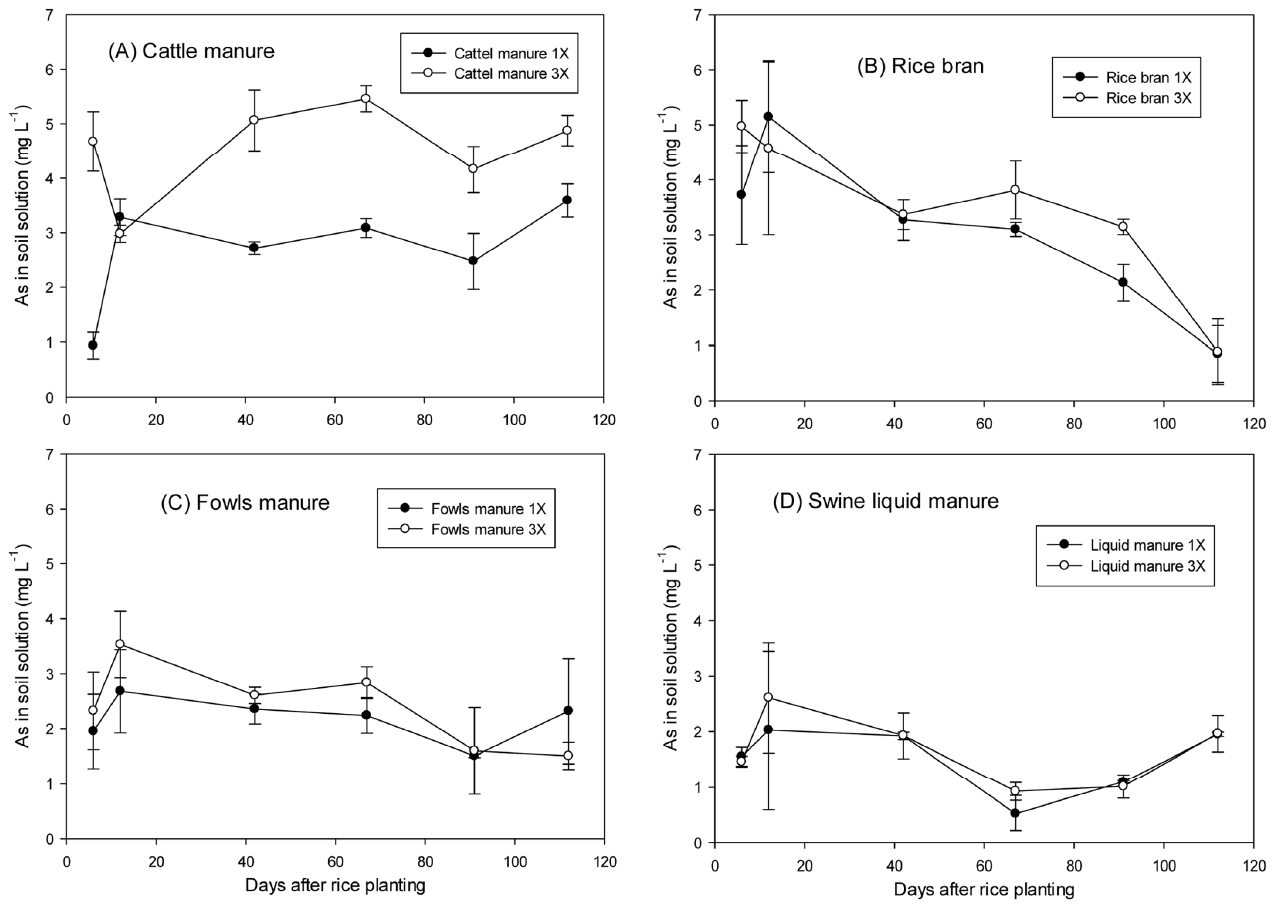
Fig.┬Ā3.
As content in soil solutions from each treatment after rice planting. Values are presented as the mean ┬▒ SD (n = 3). Single asterisks indicate significant differences (p < 0.05) compared to the control value; double asterisks indicate significant differences (p < 0.05) upon comparison between 1% and 3% treatment for given groups.
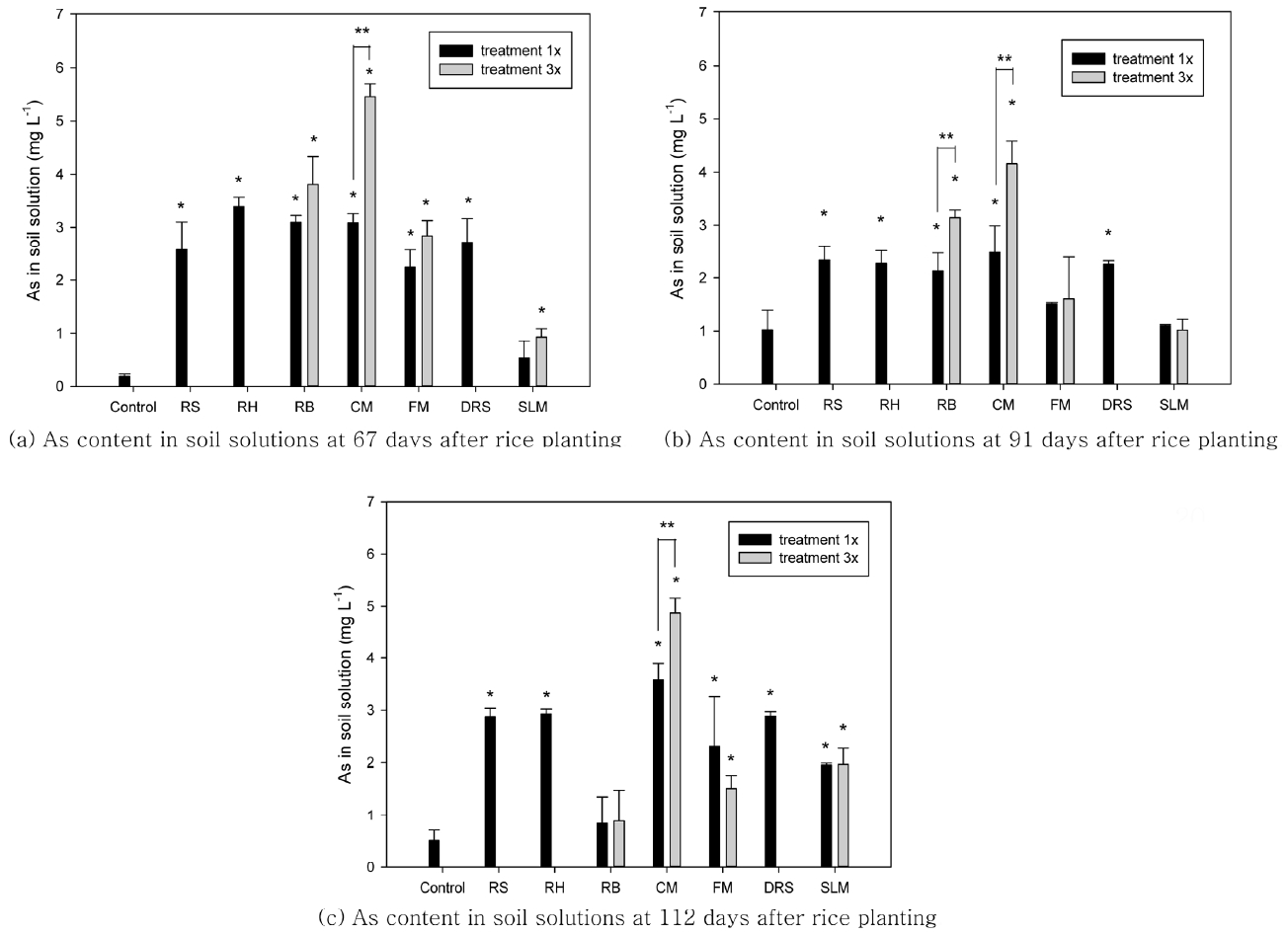
Fig.┬Ā5.
Changes in DOC content in soil solutions for two different application rate of organic matter after rice planting.
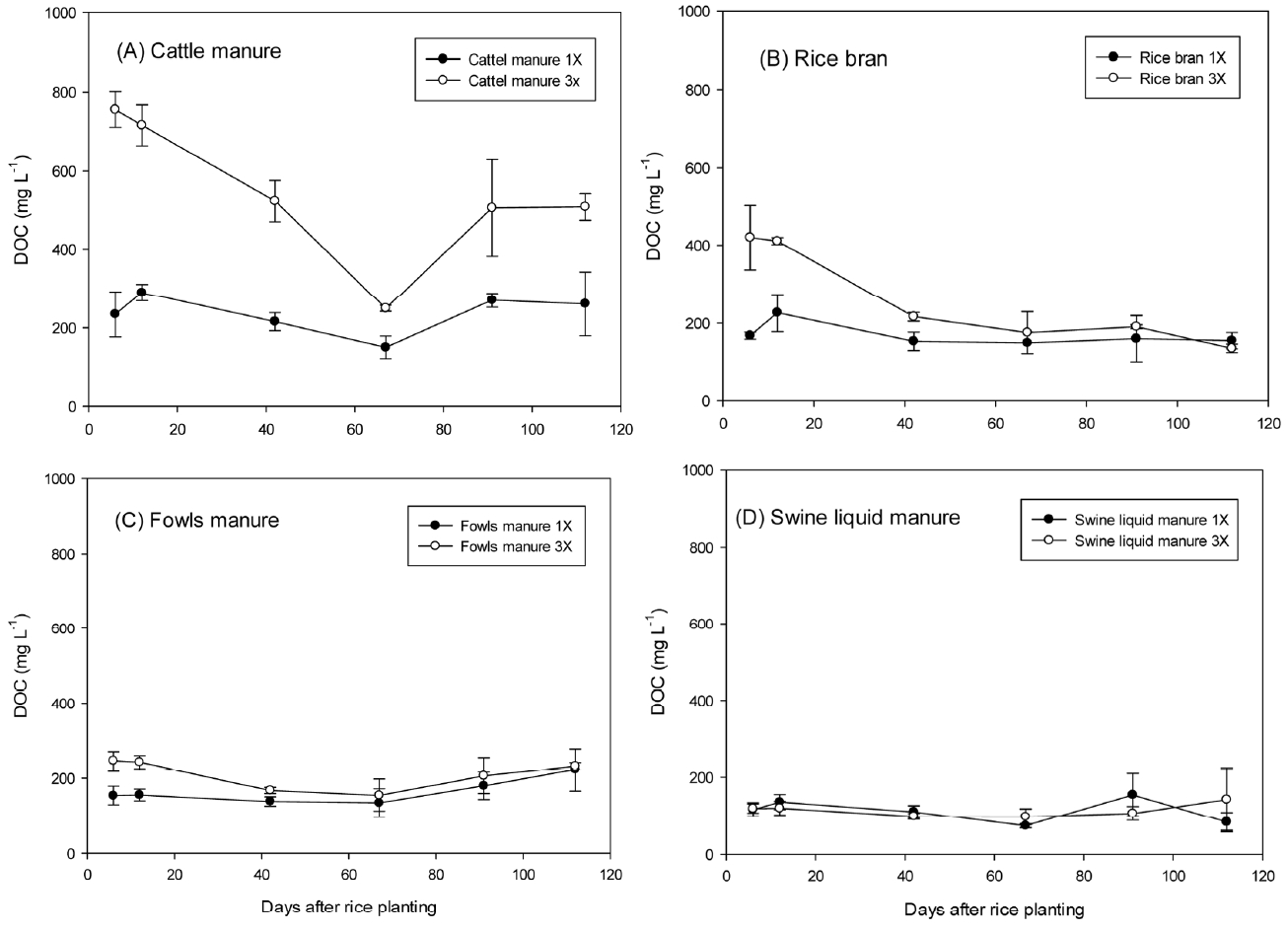
Table┬Ā1.
Organic matter treatments to each pot soil
| Treatment | Legend | Amount addeda |
|---|---|---|
| Rice straw | RS | 1% |
| Rice hull | RH | 1% |
| Rice bran_low | RB 1X | 1% |
| Rice bran_high | RB 3X | 3% |
| Cattle manure_low | CM 1X | 1% |
| Cattle manure_high | CM 3X | 3% |
| Fowls manure_low | FM 1X | 0.5% |
| Fowls manure_high | FM 3X | 1.5% |
| Decomposed rice straw | DRS | 1% |
| Swine liquid manure_low | SLM 1X | Recommended application rateb |
| Swine liquid manure_high | SLM 3X | 3 times of recommended application rate |
Table┬Ā2.
Selected chemical properties of studied soil
| pH (1:5) | ECa (dS m-1) | OMb (g kg-1) | Avail. P2O5 (mg kg-1) | Total N (%) | Sand | Silt | Clay | Soil texture |
|---|---|---|---|---|---|---|---|---|
|
(%) |
||||||||
| 5.7 | 0.16 | 18.5 | 39.6 | 0.07 | 49.6 | 35.4 | 15.0 | loam |
Table┬Ā3.
Heavy metal(loid) content of studied soil
| Element | Cd | Pb | Zn | Cu | As | Ni |
|---|---|---|---|---|---|---|
| Total content (mg kg-1) | 0.1 | 55 | 63 | 25 | 126 | 29 |
| Worrisome levela | 4 | 200 | 300 | 150 | 25 | 100 |
| Countermeasure standardb | 12 | 600 | 900 | 450 | 75 | 300 |
Table┬Ā4.
Heavy metal(loid) content of organic matter used in this study (mg kg-1 dry weight)
Table┬Ā5.
C:N ratios of organic matter used in this study
| Organic matter | C:N ratio |
|---|---|
| Rice hull | 131 |
| Rice bran | 130 |
| Rice straw | 80.3 |
| Decomposed rice straw | 56.5 |
| Cattle manure | 20.5 |
| Fowls manure | 14.4 |
| Swine liquid manure | 2.3 |
Table┬Ā6.
Pearson correlation coefficients between As in soil solution and soil solution constituents for each day after rice planting
| DAPa | Fe | Mn | pH | DOCc |
|---|---|---|---|---|
| 12 | 0.818*** | nsb | ns | ns |
| 42 | ns | ns | ns | 0.839*** |
| 67 | ns | ns | ns | 0.494** |
| 91 | 0.627*** | ns | ns | 0.741*** |
| 112 | 0.448* | ns | -0.535** | 0.624*** |
Table┬Ā7.
Mean As content in brown rice, and C:N ratios of organic matter added for each treatment
| Treatment | rice As (mg kg-1) | C:N Ratio |
|---|---|---|
| Control | 0.34 | 10.1a |
| Rice hull | 0.78** | 131 |
| Rice bran_L | 0.82** | 130 |
| Cattle manure_L | 0.68** | 20.5 |
| Fowls manure_L | 0.55 | 14.4 |
| Fowls manure_H | 0.62 | 14.4 |
| Swine liquid manure_L | 0.33 | 2.3 |
| Swine liquid manure_H | 0.36 | 2.3 |
ņ░ĖĻ│Āļ¼ĖĒŚī
1. National Research Council, Arsenic in Drinking Water-2001 Update, 2001, National Academy Press, Washington, D.C..
2. X. Y. Xu, S. P. McGrath, A. A. Meharg, and F. J. Zhao, ŌĆ£Growing rice aerobically markedly decreases arsenic accumulationŌĆØ, Environmental Science and Technology, 2008, 42, 5574-5579.


3. Codex Alimentarius Commission (CAC), Report on thirty-seventh session of Codex Alimentarius Commission, 2014.
4. Codex Alimentarius Commission (CAC), Report on thirty-ninth session of Codex Alimentarius Commission, 2016.
5. Ministry of Food and Drug Safety (MFDS), Korean Food Standards Codex, 2016.
6. Codex Alimentarius Commission (CAC), Report on fortieth session of Codex Alimentarius Commission, 2017.
7. U. S. Food and Drug Administration, FDA Looks for Answers on Arsenic in Rice, FDA Consumer Health Information, 1-2. 2012.
8. P. Sharma, M. Rolle, B. Kocar, S. Fendorf, and A. Kappler, ŌĆ£Influence of natural organic matter on arsenic transport and retentionŌĆØ, Environmental Science and Technology, 2011, 45, 546-553.


9. P. N. Williams, H. Zhang, W. Davison, A. A. Meharg, M. H. Sumon, G. J. Norton, H. Brammer, and M. R. Islam, ŌĆ£Organic matter- solid phase interactions are critical for predicting arsenic release and plant uptake in Bangladesh paddy soilsŌĆØ, Environmental Science and Technology, 2011, 45, 6080-6087.


10. S. Paikaray, S. Banerjee, and S. Mukherji, ŌĆ£Sorption of arsenic onto Vindhyan shales: Role of pyrite and organic carbonŌĆØ, Current Science, 2005, 1580-1585.
11. P. K. Sahoo, and K. Kim, ŌĆ£A review of the arsenic concentration in paddy rice from the perspective of geoscienceŌĆØ, Geosciences Journal, 2013, 17 (1), 107-122.

12. G. J. Norton, E. E. Adomako, C. M. Deacon, A. M. Carey, A. H. Price, and A. A. Meharg, ŌĆ£Effect of organic matter amendment, arsenic amendment and water management regime on rice grain arsenic speciesŌĆØ, Environmental Pollution, 2013, 177, 38-47.


13. J. Rinklebe, and G. D. Laing, Factors controlling the dynamics of trace metals in frequently flooded soils. In: H.M. Selim, 2011, 245-270. editors. Dynamics and Bioavailability of Heavy Metals in the Rootzone, Taylor & Francis Group, New York.
14. H. Rupp, J. Rinklebe, S. Bolze, and R. Meissner, ŌĆ£A scale depended approach to study pollution control processes in wetland soils using three different techniquesŌĆØ, Ecological Engineering, 2010, 36, 1439-1447.

15. H. A. L. Rowland, C. Boothman, R. Pancost, A. G. Gault, D. A. Polya, and J. R. Lloyd, ŌĆ£The role of indigenous microorganisms in the biodegradation of naturally occurring petroleum, the reduction of iron, and the mobilization of arsenite from West Bengal aquifer sedimentsŌĆØ, Journal of Environmental Quality, 2009, 38, 1598-1607.


16. A. van Geen, J. Rose, S. Thoral, J. M. Garnier, Y. Zheng, and J. Y. Bottero, ŌĆ£Decoupling of As and Fe release to Bangladesh groundwater under reducing conditions. Part II: evidence from sediment incubationsŌĆØ, Geochimica et Cosmochimica Acta, 2004, 68, 3475-3486.

17. W. J. Fitz, and W. W. Wenzel, ŌĆ£Arsenic transformations in the soil-rhizosphere-plant system: fundamentals and potential application to phytoremediationŌĆØ, Journal of Biotechnology, 2002, 99 (3), 259-278.


18. Y. Takahashi, R. Minamikawa, K. H. Hattori, K. Kurishima, N. Kihou, and K. Yuita, ŌĆ£Arsenic behavior in paddy elds during the cycle of flooded and non-flooded periodsŌĆØ, Environmental Science & Technology, 2004, 38, 1038-1044.


19. M. Grybos, M. Davranche, G. Gruau, and P. Petitjean, ŌĆ£Is trace metal release in wetland soils controlled by organic matter mobility or Fe-oxyhydroxides reduction?ŌĆØ Journal of Colloid and Interface Science, 2007, 314, 490-501.


20. C. F. Lin, C. H. Wu, and H. T. Lai, ŌĆ£Dissolved organic matter and arsenic removal with coupled chitosan/UF operationŌĆØ, Separation and Purification Technology, 2008, 60, 292-298.

21. S. M. Shaheen, J. Rinklebe, H. Rupp, and R. Meissner, ŌĆ£Lysimeter trials to assess the impact of different flood-dry-cycles on the dynamics of pore water concentrations of As, Cr, Mo and V in a contaminated floodplain soilŌĆØ, Geoderma, 2014, 228-229, 5-13.

22. J. Yan, H. Huang, Z. Chen, and Y. G. Zhu, ŌĆ£Arsenic uptake by rice is influenced by microbe-mediated arsenic redox changes in the rhizosphereŌĆØ, Environmental Science and Technology, 2014, 48, 1001-1007.


23. Rural Development Administration (RDA), Research, survey and analysis standard for agricultural science and technology, 2012.
24. National Institute of Agricultural Sciences (NIAS), Methods of soil chemical analysis, 2010.
25. Ministry of Environment (MOE), Official methods of soil analysis for polluted soils, 2010.
26. A. Suda, K. Baba, N. Yamaguchi, I. Akahane, and T. Makino, ŌĆ£The effects of soil amendments on arsenic concentrations in soil solutions after long-term flooded incubationŌĆØ, Soil Science and Plant Nutrition, 2015, 61 (4), 1-11.

27. A. R. M. Solaiman, A. A. Meharg, A. G. Gault, and J. M. Charnock, ŌĆ£Arsenic mobilization from iron oxyhydroxides is regulated by organic matter carbon to nitrogen (C:N) ratioŌĆØ, Environment International, 2009, 35 (3), 480-484.

28. F. A. Weber, A. F. Hofacker, A. Voegelin, and R. Kretzschmar, ŌĆ£Temperature dependence and coupling of iron and arsenic reduction and release during flooding of a contaminated soilŌĆØ, Environmental Science and Technology, 2010, 44, 116-122.


29. N. Yamaguchi, T. Nakamura, D. Dong, Y. Takahashi, S. Amachi, and T. Makino, ŌĆ£Arsenic release from flooded paddy soils is influenced by speciation, Eh, pH, and iron dissolutionŌĆØ, Chemosphere, 2011, 83 (7), 925-932.


30. A. Signes-Pastor, F. Burl├│, K. Mitra, and A. A. Carbonell-Barrachina, ŌĆ£Arsenic biogeochemistry as affected by phosphorus fertilizer addition, redox potential and pH in a west Bengal (India) soilŌĆØ, Geoderma, 2007, 137, 504-510.

31. K. R. Reddy, and R. D. DeLaune, Biogeochemistry of wetlands: science and applications, 2008, CRC Press, Boca Raton.
32. Z. L. He, J. Shentu, and X. E. Yang, Manganese and selenium. In: P.S. Hooda, editors. Trace elements in soils, 2010, 481-497. John Wiley & Sons Ltd., United Kingdom.
- TOOLS
-
METRICS

-
- 2 Crossref
- 2,968 View
- 31 Download
-
Related articles in
J Environ Anal Health Toxicol




